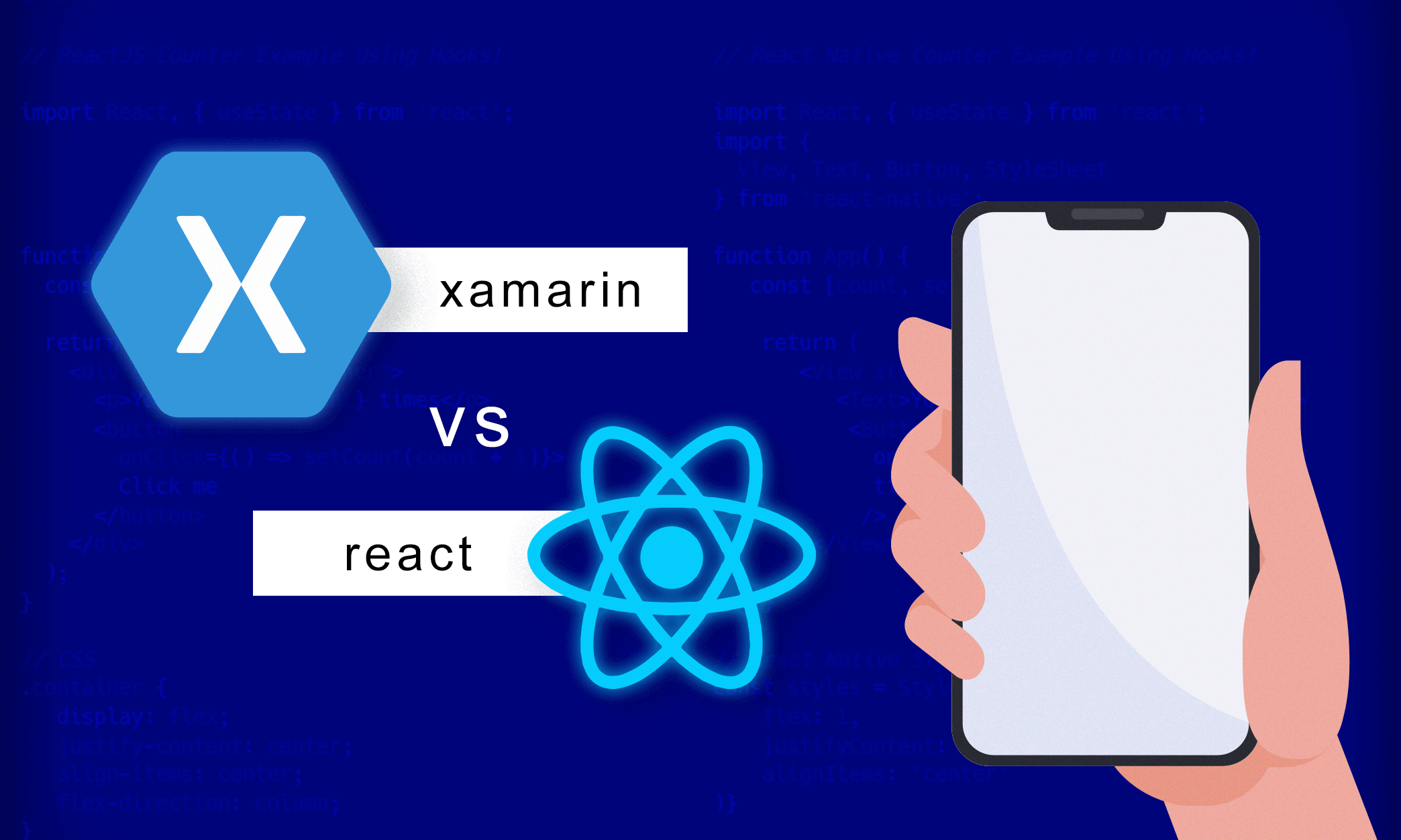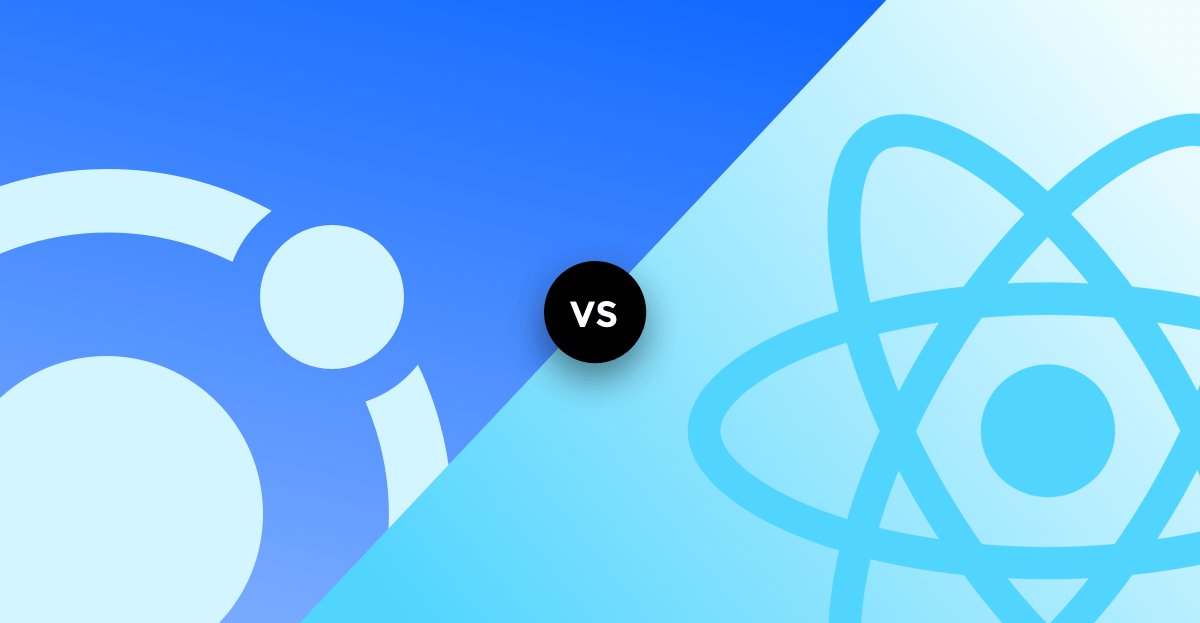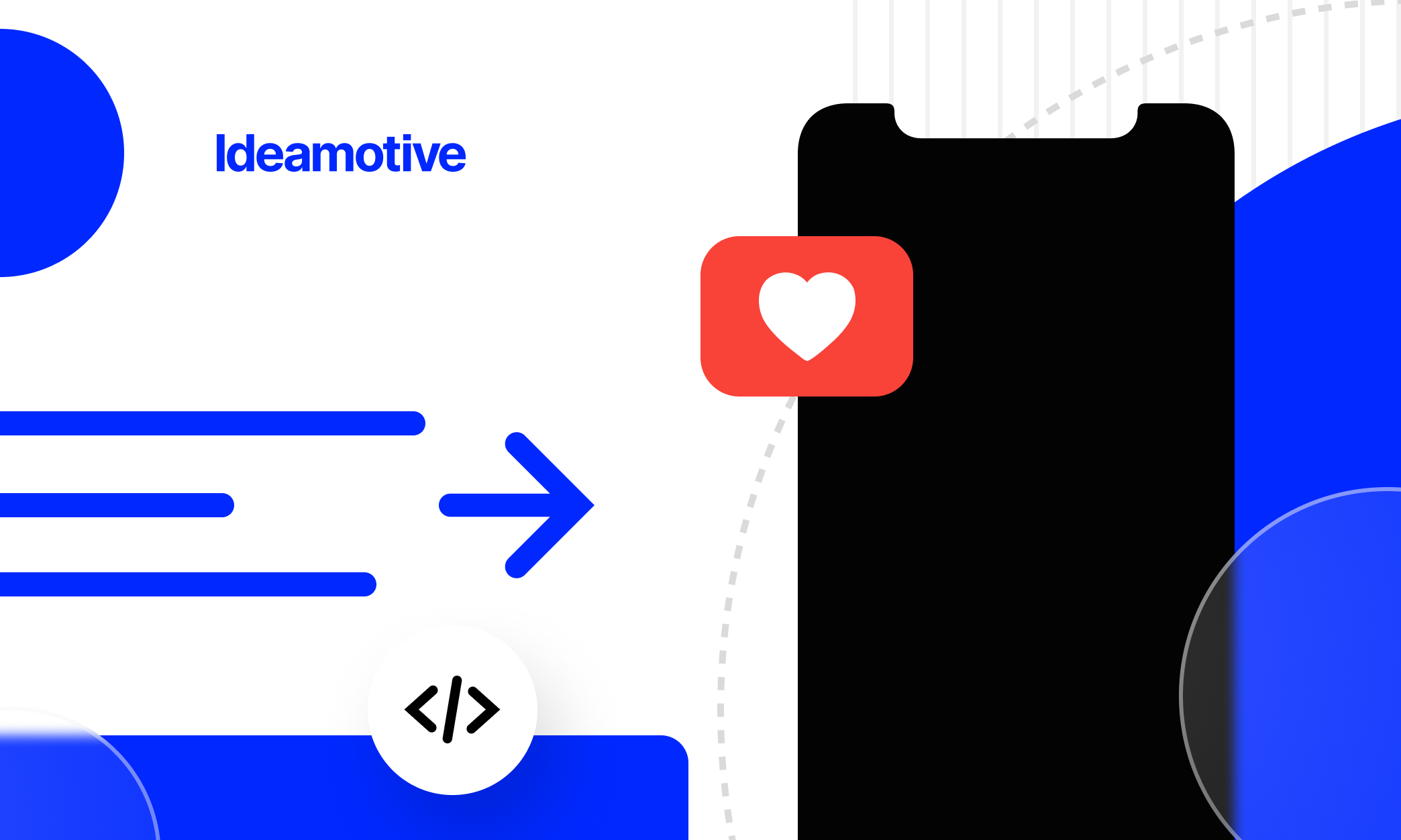Android Development
Business Guide 2022
For Startup CEOs, Entrepreneurs And Product Owners
Introduction. Why Android?
In this in-depth guide, we offer you a fresh look at Android. It is a fairly rapidly developing platform. A new version is released almost every year, bringing new features for users and a variety of goodies for developers.
In this regard, your work will never turn into routine maintenance of a stable version. There will always be something new. There will always be somewhere to move. For example, it wasn’t that long ago that Google announced Kotlin as the official development language for Android.
Indeed, smartphones and other mobile devices have become more than just a part of our daily life. With the help of mobile phones, we not only communicate with each other but also order goods from stores, buy tickets, book accommodation, call taxis, use navigation, take photos and videos, access reading rooms, online banks, and ways to have fun and pass the time.
According to statistics published by Datareportal, 67% of adults around the world use smartphones every day, which is almost 5.19 billion people (out of a total population of 7.75 billion). The transition from simple mobile devices to multifunctional smartphones is only increasing every year.
It would seem difficult to come up with something new, but developments in collaboration with good marketing can bring a lot of money to the creator. A clear confirmation of this is the recently sensational TikTok, whose ratings continue to grow at lightning speed.
Who is this guide for?
This guide is not about Android coding. It is not aimed at developers. This is an ultimate collection of data meant for people in business who want to understand Android application development and its business implications, opportunities, and perspectives.
Business developers and CEOs of startups can find interesting solutions for their existing projects or be inspired to build new ones.
Mobile product owners can see this Android guide as a manual on how to develop their projects.
Marketing managers/brand managers in big companies who need to create an app to promote and sell a product.
Digital entrepreneurs who need some fresh ideas for their irresistible, interactive business pitch in order to make investors believe in their project.
Whoever you are, you can be sure this guide won’t leave your head quietly. Even an experienced business developer will find some food for thought!
What will you learn from this guide?
Bookmark this guide so you could read it whenever you need ideas. However, the core things we want you to remember are:
-
What makes Android app development your best choice, and why thousands of companies turn to it each year.
-
Which amazing things are subject to Android, and which ones are not.
-
What your options for Android application development are.
-
What the development process includes, and what you should keep in mind when hiring Android developers.
-
Where to hire the best Android team for your next project.
Want to get started but can’t read the guide online? Download the PDF version of this page.
By clicking “Get the e-book” you consent to processing your data by Ideamotive Sp. z o. o. for marketing purposes, including email marketing.
.png)
Thinking about building an Android app?
Talk to our tech advisor. We will audit your requirements, prepare a product roadmap and put together an A-class development team.
Table of Contents
00 State of Android in 2022 [INFOGRAPHIC]

01 What is Android?
Android is a free operating system that runs on smartphones, tablets, game consoles, wristwatches, TVs, multimedia players, e-Book readers, and Google glasses.
Often, manufacturers of modern devices replace standard OS elements with proprietary applications, group menu items differently, and change their names. However, the essence of the system operation in most proprietary shells is identical.
Android history
Android OS was developed by Andy Rubin.
In 2005, Rubin ran out of money and turned to many companies and managed to catch the attention of the folks from Google. On July 11, 2005, they bought the company, and Android developers, including Rubin, began working on the system under Google's wing.
The Android operating system was released on September 23, 2008.
Android is now installed on over 3 billion devices worldwide.
(Source)In 2007, the iPhone ruled the show. It wasn’t until the release of Motorola's Droid, which was technically more powerful and more functional than the iPhone, that Google managed to change the situation a little.
People began to take Android seriously in 2009 - they began to see it as the main competitor to Apple smartphones. And if it were not for distributing the system as an open OS, it is unlikely that it would occupy 80% of the market today.
Which programming languages are used for developing Android apps?
The languages you can use to develop Android apps are:
1. Java: Java is the official programming language for the Android platform and is supported by Android Studio.
2. Kotlin: This has become the second official programming language for the Android platform.
3. C/C++: Android Studio supports the C++ programming language, but only when used in conjunction with the Android NDK.
4. C#: This is a more convenient and beginner-friendly alternative to C or C++. C# code tends to be simpler and more concise. This language is supported by tools such as Unity and Xamarin, which are great for cross-platform game and application development.
5. Python. Rather an unusual choice, but there are open-source Python libraries, such as Kivy that can be used for mobile app development.
6. React Native + JavaScript/TypeScript. A neat and developer-friendly cross-platform solution created by Facebook itself.
7. Flutter + Dart. Flutter is a software development kit that uses Dart programming language and allows building powerful cross-platform mobile applications.
8. Cordova. A hybrid app development solution that lets you design, compile and deploy highly functional mobile applications.
9. NativeScript. NativeScript apps are built using JavaScript or any language that translates to JavaScript, such as TypeScript.
10. Ionic. One of the powerful HTML5 SDK that allows development of natural-feeling mobile apps using technologies like HTML, CSS, and JavaScript.
Find a detailed comparison of these technologies in Section 4.
What Android is used for
Today, Android is more than just an OS for smartphones. We can see this technology in other gadgets:
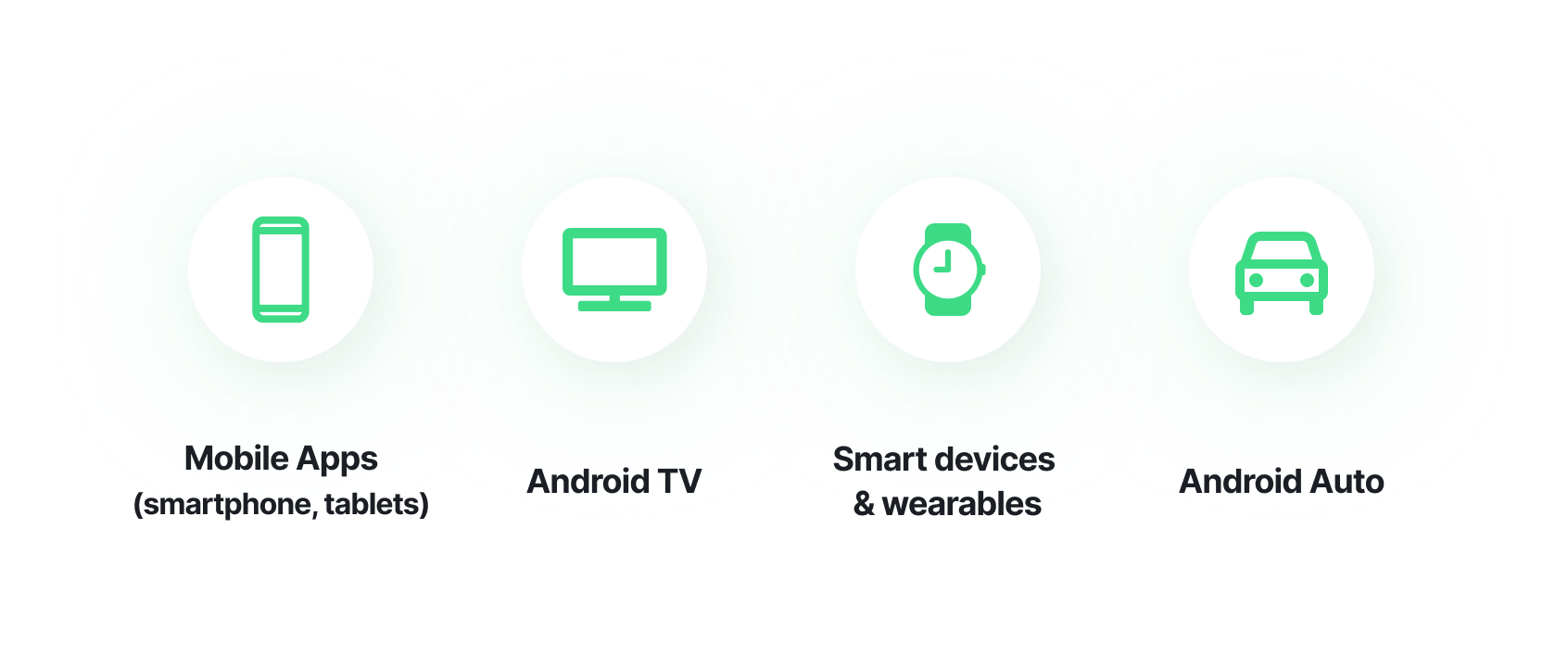
Android is a very flexible operating system. It is easy to customize it to suit your own needs, and an abundance of applications allows you to get additional functionality or replace basic functions.
Don't like the standard dialer? It doesn't matter — download another application, replace the shortcuts on the desktop and use the new dialer.
Don't like the built-in music player? It is easy enough to download another one from the Play Store.
Want to see a more detailed explanation? Jump to Chapter 3!
Versions of Android
Here is a list of all Android versions:
- Android 1 "Apple Pie"
- Android 2.3 Gingerbread (Released 2010)
- Android 4.0 Ice Cream Sandwich (Released 2011)
- Android 4.1 Jelly Bean (Released 2012)
- Android 4.2 (Released 2012)
- Android 4.3 (Released 2013)
- Android 4.4 KitKat (release date 2013)
- Android 5.0 Lollipop (Released 2014)
- Android 5.1 (Released 2015)
- Android 6.0 Marshmallow (Released 2016)
- Android 7.0 Nougat (Released 2016)
- Android 7.1 (Released 2016)
- Android 8.0 Oreo (release date 2017)
- Android 8.1 (release date 2017)
- Android 9.0 Pie (Released 2018)
- Android 10 (release date 2019)
- Android 11 (release date 2020)
To read more about the current version of Android, jump to this section.
02 Android vs iOS
Whatever you choose, it is recommended to have at least two alternatives to compare it to. In the case of deciding on an app development technology, the same approach is taken.
Now, for smartphones, only two operating systems are commonly used — Android and iOS. About 99 percent of all mobile devices sold use these OSes.
But which OS is better?
A categorical answer to this question cannot be given since the comfort of a gadget is an individual user experience, and each has their own requirements for the software and interface.
Therefore, in order to make the right choice, you must take everything into account — both your wishes for the mobile app and what the available software is capable of.
You can always go (as many people do) with developing your application for both iOS and Android at the same time using cross-platform development technologies. We cover this in detail in this section.
What is iOS?
iOS is a mobile operating system created and developed by Apple exclusively for its devices.
The iPhone and iPod Touch run iOS. It was previously installed on the iPad before the release of iPadOS in 2019. It is the second most popular mobile operating system right after Android.
iOS was introduced to the public in 2007 on June 29 with the first iPhone, after which it was ported to the iPod Touch and the iPad.
iOS supports the installation of third-party applications that allow you to complete many different tasks and expand the functionality of the device. At the moment, there are more than two million applications and games available in the official App Store.
How is iOS different from Android?
What are the main differences between Android and iOS?
Android vs. iOS Interface
This is one of the most important aspects because we look at the screens of our smartphones a hundred times a day. Some people believe that most Android smartphones copy the iOS interface, but there are more launcher customization options available for Android.
Different themes (with different icons), live wallpapers, etc., are available for Android smartphones. However, the biggest difference is the widgets. They display real-time information about the weather, promotions, news, your plans, etc. On smartphones with Android, widgets can be added directly to the main home screen.
Widgets arrived on iOS much later, and they are available on a separate screen. We think that this is rather inconvenient, and widgets have needed to be modernized for a long time.
The interface in both operating systems is largely the same. But on Android, making changes and installing overlays is not a problem, while on iOS, changes are limited — they can be very surface level, even cosmetic, and the user has to select and use only pre-designed templates with ready-made designs.
But here, it is imperative to be honest and note that both the design and the interface of the Apple OS are perfectly optimized and really very user-friendly, so such restrictions in customizing the gadget are not really a problem for the user.
Android vs. iOS Development Speed + Cost + Ease
Developing for iOS is faster, easier, and cheaper — according to some estimates, development time for Android is 30-40 percent longer.
One of the reasons iOS is easier to develop for is because of code. Android applications are usually written in Java, a language that requires more code to be written than Swift, Apple's official programming language.
Another reason is that Android is an open-source platform. Lack of standardization means more devices, more components, and software fragmentation have to be accommodated.
Apple's closed ecosystem means you develop for multiple standardized devices and operating systems.
However, the Apple App Store has stricter quality guidelines and requirements and a longer review process. Therefore, it may take longer for apps to be approved. Your app might even get rejected if it doesn't meet Apple’s standards.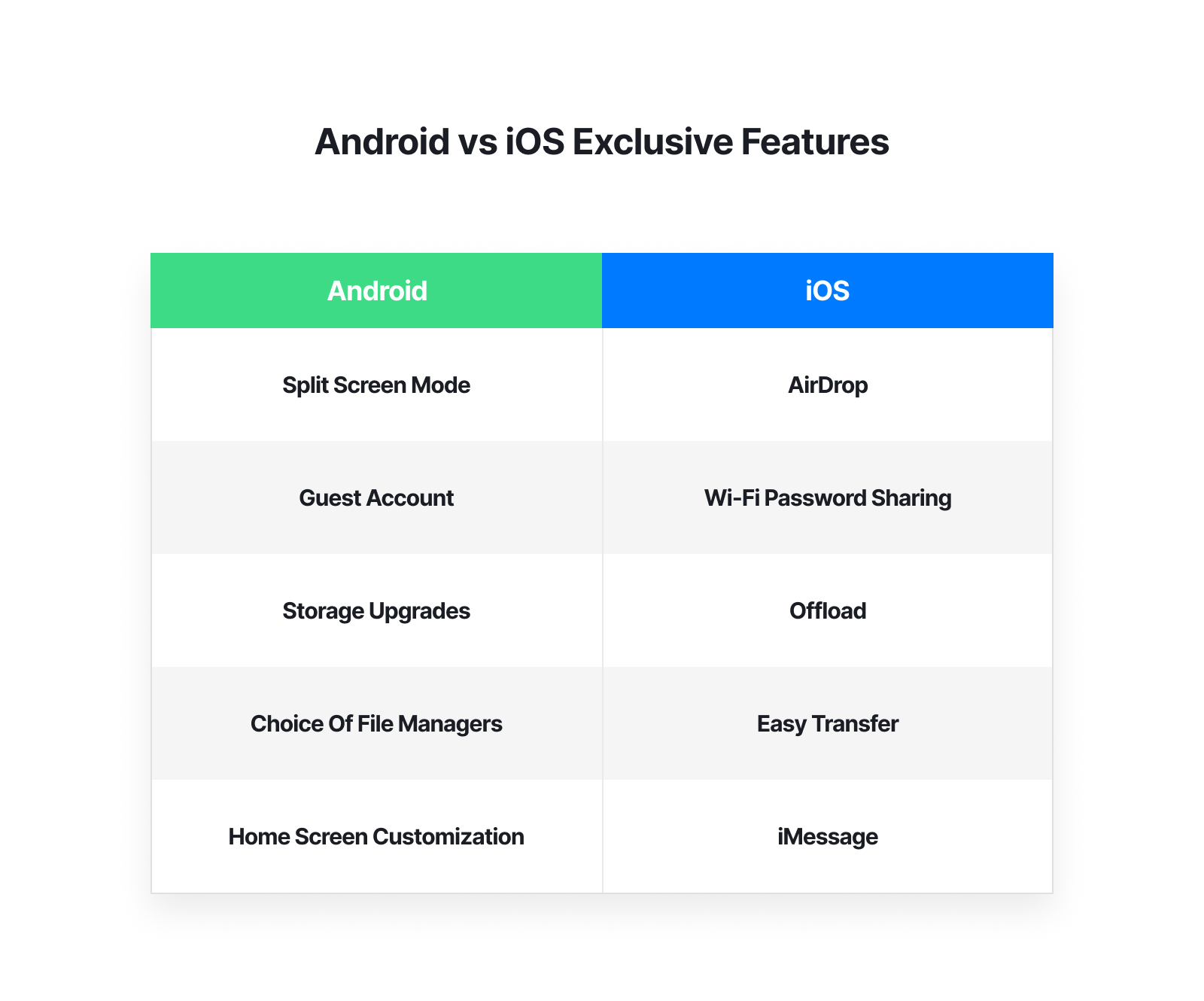
Android vs. iOS Speed
iOS is faster. This is because Android applications use the Java runtime. iOS was designed from the start to use memory efficiently and avoid this type of garbage collection. Hence, an iOS product can run faster with less memory and is capable of delivering battery life similar to many Android phones with much larger batteries.
Android vs. iOS Stability
The stability and smoothness of the smartphone system are the main things most users notice. Thanks to its optimization, a well-thought-out interface, and the same technical components across devices, Apple's system takes the lead in this category.
The variety of Android devices and different graphics firmware negatively affects Android’s smoothness. Moreover, Google does not promise stability when it comes to modifications made by third-party manufacturers: they have vulnerabilities and often freeze, which leads to the need to reboot the device.
This also applies to the hardware: manufacturers use different components, and some of them do not have official Google support.
The situation with iOS is better: if there are problems with the internal components of the device, it's not the system but the gadget. The company will quickly replace your device with a new one.
iOS vs. Android Security
Comparing iOS vs. Android when it comes to privacy and security, we have to say that in some circles, Apple's iOS has long been considered the most secure of the two operating systems. Why? Apple's operating system is a closed system. Apple does not provide its source code to app developers, and iPhone and iPad owners cannot change the code on their devices themselves. This makes it harder for hackers to find vulnerabilities on iOS devices.
On Android devices, the opposite is true: they use open source, which means that the owners of these devices can tinker with the operating systems. Too much fiddling and owners can create security vulnerabilities in their devices. Then comes the manufacturers themselves. If a phone manufacturer releases a new device with a modification to the Android operating system and there is a vulnerability in that code, hackers will find it.
Android is also targeted by hackers more often because the operating system runs on so many mobile devices. The global popularity of the Android OS makes it a more attractive target for cybercriminals. Thus, Android devices are more at risk of being infected with malware and viruses.
But that is not all. While iOS can be considered more secure, it's not impossible for cybercriminals to attack iPhones or iPads. Android and iOS device owners should be aware of potential malware and viruses. They should be careful when downloading apps from third-party app stores. It's safest to download apps from trusted sources like Google Play and the Apple App Store, which check the apps for sale.
In addition, there are social engineering attacks in which cybercriminals try to trick users into providing login details, access to bank accounts, and other personal information. It doesn't matter which mobile operating system you use: both iOS and Android can be equally vulnerable to these types of phishing attacks.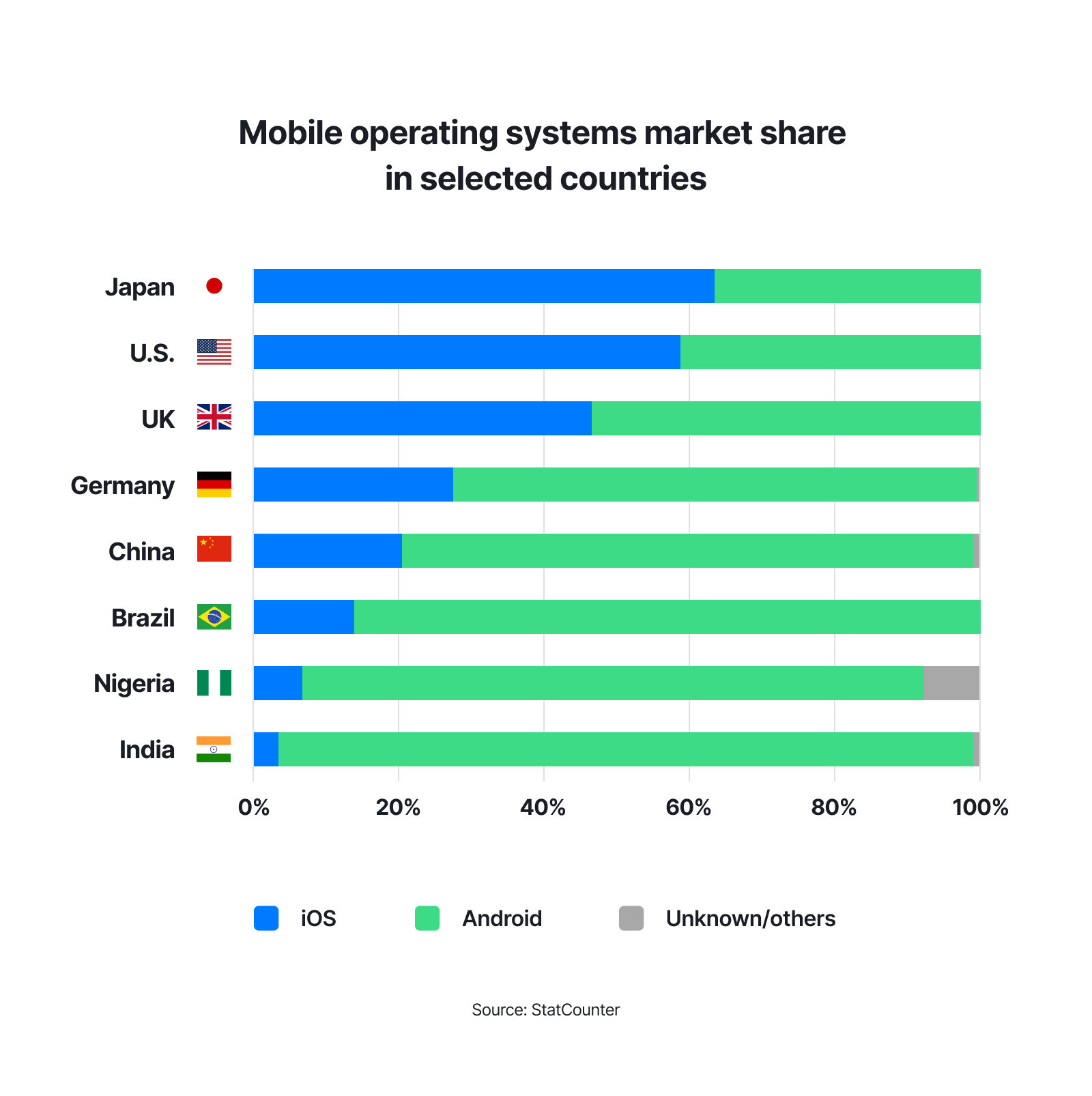
In the global mobile market, the Android operating system dominates the competition. According to Statista, in 2019, Android accounted for 87% of the global market, while Apple's iOS only accounted for 13%. This gap is expected to widen over the next few years.
Even with such a low share of the global market, iOS has managed to reign supreme in several key countries. StatCounter statistics show that the iPhone holds over 60% of the market share in Japan and over 50% in the United States. The numbers in Canada are closer to 50-50.
Regrettably for Apple, these are the only countries where their system is more popular than Android. Google's OS is more common in the UK, Germany, China, and many other countries. The iPhone has less than 20 percent of the market in Brazil, Nigeria, and India.
An important factor to consider is the price. The Apple iPhone is a high-end product with a high price tag that many in emerging economies are rejecting, comparing it to mid-range Android devices. For example, high import taxes in India push the cost of iOS devices significantly higher than the market was willing to pay. As a result, the Indian market is now 97 percent Android.
But Apple is looking to shake up the market in places like India with a new manufacturing facility in Chennai that will allow the company to compete with low-priced Android devices. Apple has also manifested interest in the mid-range market with the launch of the new iPhone SE. Thus, in the near future, Android's dominance may be challenged by iOS.
Features that Exist on Both Platforms
Some of the similarities between iOS and Android are as follows:
- The basic functionality of iOS and Android is similar. iOS and Android phones have calling, messaging, web browsing, video chat, AI assistants, maps, voice commands, mobile payments, and more.
- iOS and Android user interfaces are similar in many ways. Both of them support swiping, touching, shrinking, zooming, and more on their phone screens.
- Both iOS and Android devices have a status bar that offers similar information, such as battery life, time, app notifications, Wi-Fi status, etc.
- The 4G (and in some phones, 5G) cellular network can be used on both iOS and Android devices. This is very important as the cellular network is critical to using the internet.
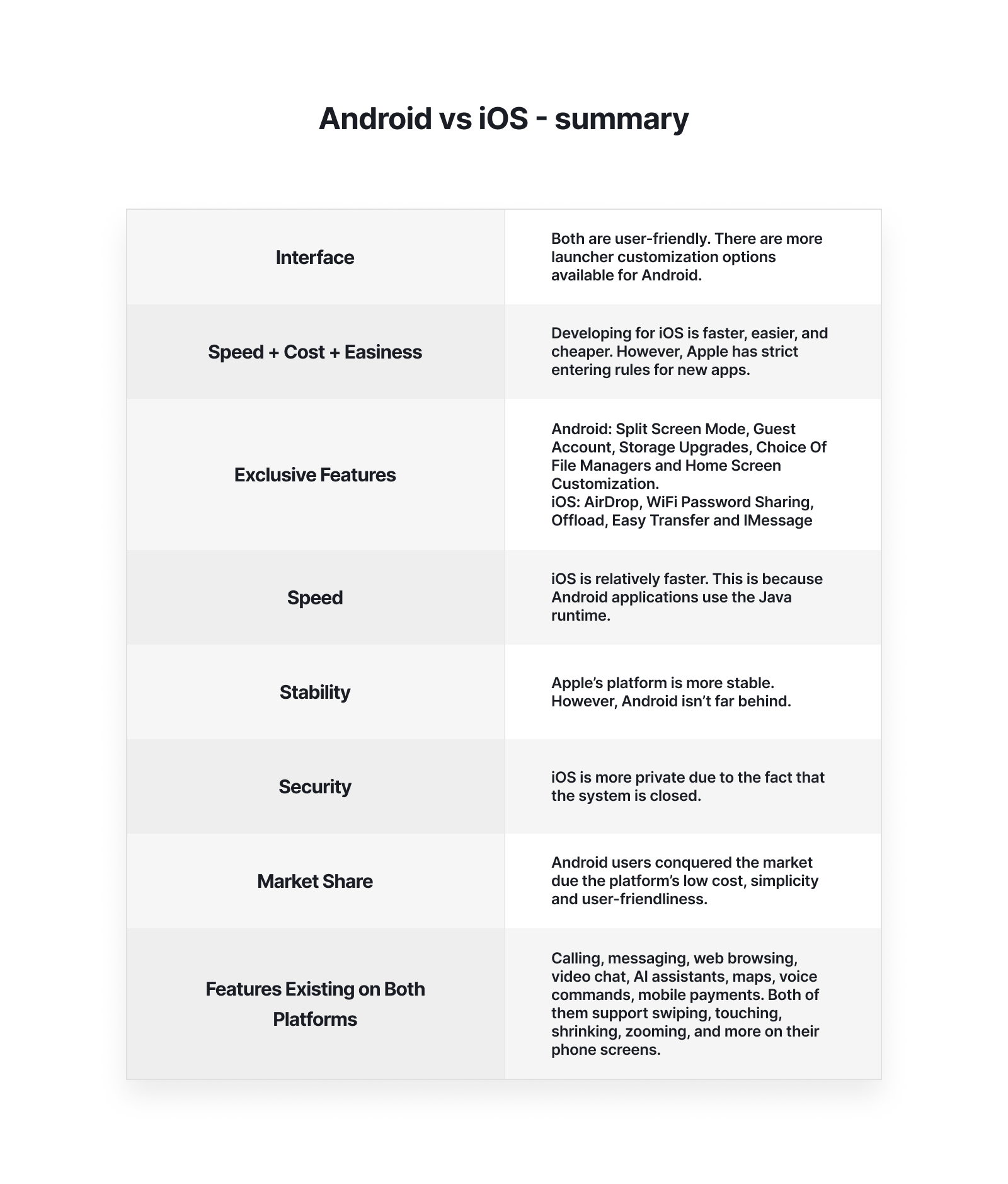
Android vs. iOS Pros and Cons
To make it easier for you to understand the characteristics of these two operating systems, we have summarized the main advantages and disadvantages of iOS and Android into two tables. Let's start by analyzing the features of the Android operating system:
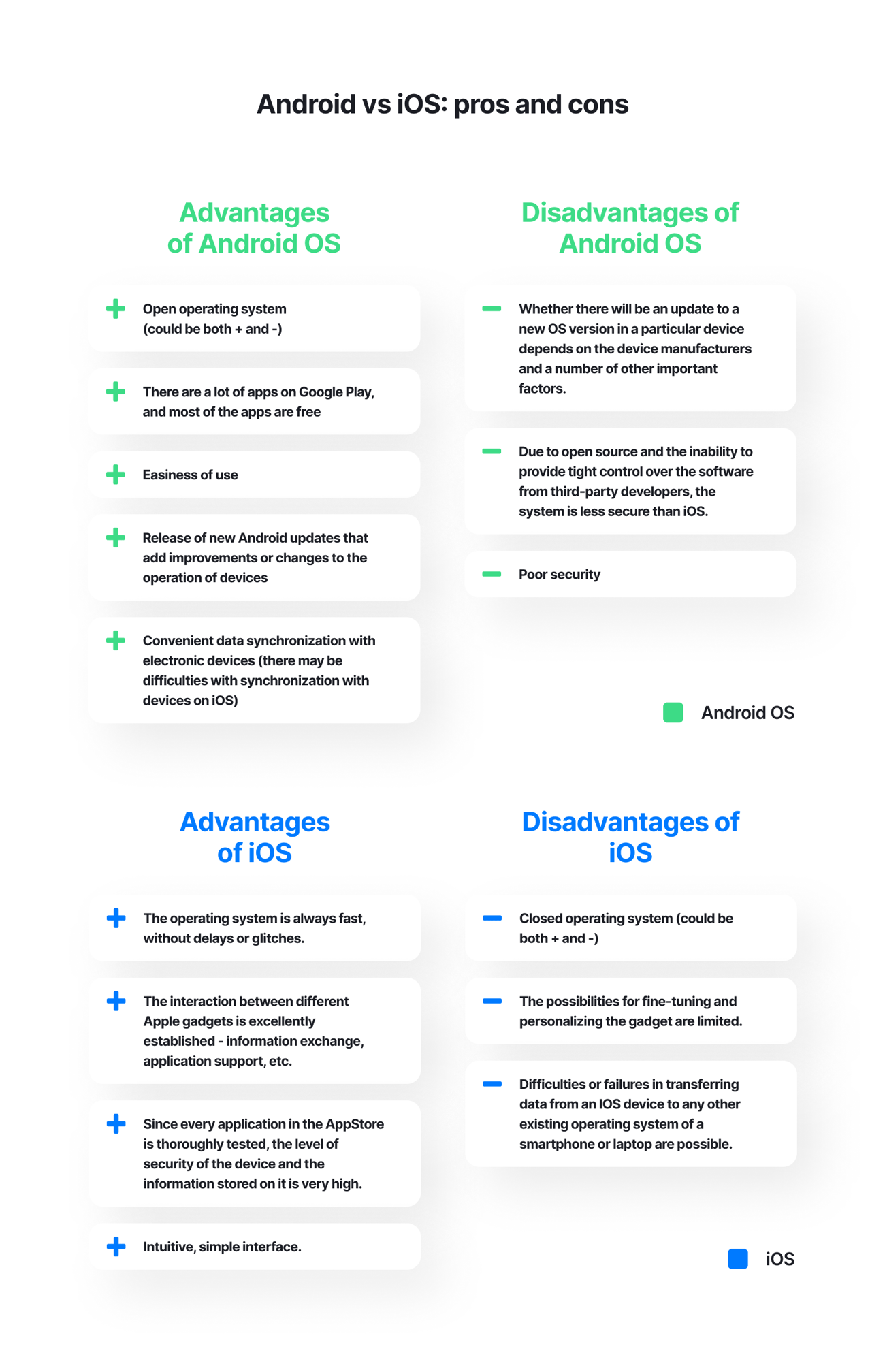
What should you choose? Ideally: both. But if that’s not possible, go with Android because everything, including how menus are displayed and how the app is controlled, can be customized, as well as the ability to add custom functions and settings.
Android is the choice for users who value maximum freedom and want flexible settings. It’s also for those who are looking for good but inexpensive solutions.
03 Why Android? What is Android used for?
The Android operating system was originally created for a narrow class of gadgets — smartphones. The first "lab" versions of this OS didn't even have touch screen support. However, Android can now be found inside any gadget, even household appliances.
Where is Android used?
The fact that the first Android version did not support touchscreen operation is not surprising: then, in mid-2006, there were still a few months left before the iPhone was announced. However, after Steve Jobs presented his revolutionary device, Google made significant adjustments to the new OS — Android received support for touchscreens and a completely different interface.
Further evolution of the platform has led to it ceasing to be only a "smartphone" operating system. Android is used on a wide variety of devices today, and this number is likely to grow.
Here's a short list of consumer device where Android is used.
Mobile Apps
It would not make sense to list any specific models. Today, almost all manufacturers have smartphones and tablets based on Android.
If the tablet is not an iPad, then it probably runs the Android operating system. (There are also models based on Windows, but their market share is vanishingly small — it hardly exceeds half a percent).
Remember, mobile Android devices are essentially the only alternative to Apple's iOS.
Smart devices & wearables
Multimedia book readers
There doesn't seem to be much difference between Android-based readers and tablet computers, but, nevertheless, readers on this platform usually come with advanced software for reading books and are often equipped with special hardware keys for turning pages. They also usually do not have satellite GPS navigation receivers or cellular network modules.
Note that such devices are made by the two world leaders in the e-Book reader market — American companies Amazon and Barnes & Noble.
What does Android do for a multimedia reader? The user gets a two in one device: a convenient gadget for reading e-Books and a tablet computer with the ability to install third-party software and games.
Wearables
Android has even "settled" in a wristwatch. One of the first such gadgets was released by Sony, offering the SmartWatch as an accessory for smartphones based on the same operating system (the display on the watch can show incoming SMS, calls, some applications, and so on).
The Italian brand I'm Watch has a whole line of Android watches, more than ten models with various finishes, including leather and precious metals.
An Android watch is a pretty interesting addition to a smartphone or tablet since you don't have to take the "main" device out of your pocket or bag to read an email or message.
Portable Game Consoles
The first Android game console was the ODROID, released a couple of years ago. And the now defunct company Sony Ericsson once released the XPERIA Play smartphone, which was a hybrid of the smartphone and a set-top box.
Why Android consoles? It's simple: thousands of games have been written for this platform. In addition, emulators for many previous generation game consoles are available for it.
Pocket media players
Devices of this class "died out" several years ago due to the popularity of smartphones, but today, thanks to Android, they have received a second life.
Netbooks
Some versions of the Acer Aspire One netbook came with two operating systems - Windows 7 and Android 2.1. Though, there wasn’t much reason in to use Android as it is optimized for touch screens, and this netbook did not have one. But the fact remains, Android was present in this class of gadgets, although this is clearly a foreign territory for it.
Android TV
In November 2014, Google, together with Asus, released the first Android TV multimedia set-top box.
What is this operating system, and why is it necessary? Android TV is capable of transforming an ordinary TV that receives only broadcast programs into a multimedia center with a huge number of possibilities. The system initially has all the standard functions, including typical settings for reception and image quality, selection of video content sources, etc. But at the same time, it is basically a familiar OS that has all the same Android pros and cons: access to folders, a familiar procedure for installing applications, and compatibility with devices that support the system. This makes it possible to install many more applications than any other Smart TV option.
Today, Android TV is found in TVs from several manufacturers. One of the leaders in this area, Sony, offers a large selection of models based on the Android TV operating system with different sizes — from 43 to 100 inches. In addition to Sony, Sharp and Philips also use Android TV actively.
In theory, Android TV is the next step in the development of the Smart TV, but we are actually talking about a fundamentally different platform. From the point of view of an advanced user, a traditional Smart TV is a computer on which you can install programs and applications from only one developer. This is clearly not enough. The system is only suitable for non-picky internet users and those who want to slightly expand the capabilities of a standard TV by increasing the amount of content.
Android Auto
Android Auto is Google's in-car infotainment product — a piece of technology that not only provides an audio-visual connection between your car and smartphone apps, but is now ahead of Apple CarPlay. By connecting your phone to the car’s head unit, you will see a simplified version of your phone on the infotainment screen. This makes it easier and safer to use your phone when driving, and provides quick access to apps and features such as Google Maps, music, phone calls, and SMS.
Android Auto is not available on all new vehicles (nor is Apple CarPlay), but like the software on Android phones, the technology is constantly evolving and being updated. Interestingly, regular updates are one of the main benefits of using Android Auto software.
Because car manufacturers operate at a much slower pace than personal electronics makers, many drivers are often forced to use outdated multimedia systems with limited-functionality.
To use Android Auto, you need an Android smartphone that has been updated to version 5.0 Lollipop or higher. If you have the version you want, you will have a simplified user interface and a collection of compatible apps.
Android for Startups
According to these stats, users spend up to 86% of their smartphone time using applications. More than 50% of transactions and online purchases go through mobile apps, and this figure is increasing every year.
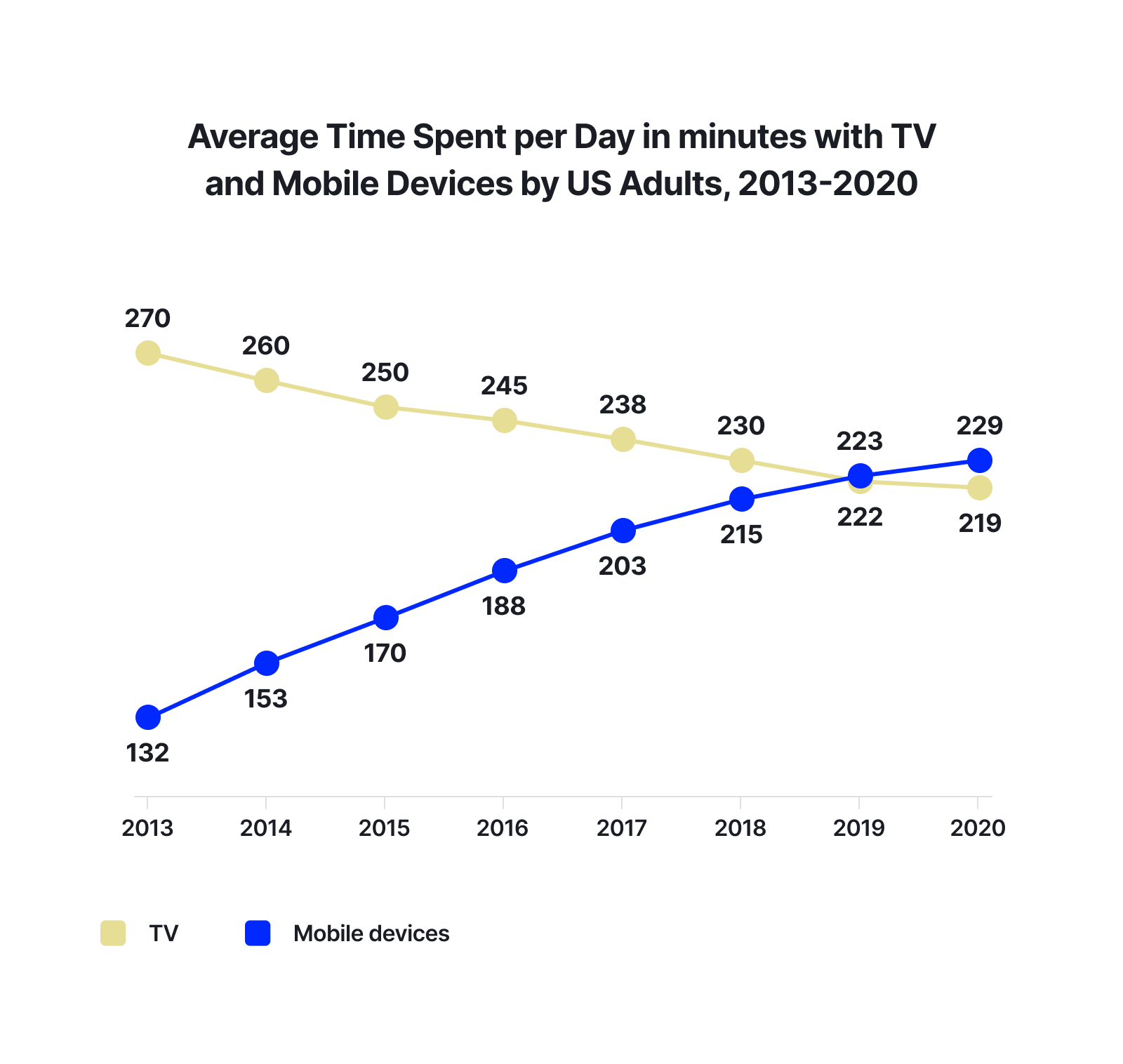
Carrying out all operations — from ordering sushi to organizing your own business — is done comfortably through a smartphone. For this reason, the lion's share of the audience prefers mobile apps to desktop services.
Changes in consumer preferences are driving the rapid development of the smartphone software market.
Therefore, to launch a mobile startup, you need a well-established OS like Android.
Android for Enterprises
There’s another reason to choose Android development. With Android 2.0, Google showed a way to manage devices through an MDM solution, in which management is performed by granting the application device control rights (Device Admin).
When adding a device, the user is prompted to "hand over" control to the Intune Company Portal app.
It worked, but it has always been more difficult to set up Android devices than iOS devices. Plus, this created a security hole since any application could gain such rights and gain full access to the system.
In order to solve these problems, Android for Work mode, or as it is now called, Android Enterprise, was created.
At the moment, Android Enterprise is a collection of methods and solutions for device management when the device is controlled through APIs provided by Google itself. That is, when you perform an action, Intune will contact Google servers to call the desired device.
Intune currently supports the following methods of using Android Enterprise:
Work Profile
This script should work for personal devices that you want to add to Intune.
When you add a device to Intune, you will be prompted to create a new work profile, and anything Intune adds to the device will be added at the profile level, not the entire device.
Kiosk or COSU devices
This is a mode in which the owner of the device is the company and not the user. In this case, no special work profiles are created, since the entire device is linked to the company.
In this case, you can configure devices with limited functionality for one or more tasks. For example, a tablet for a warehouse system or a phone for a field worker with limited features.
This is where some of the magic of the initial device setup starts to work, since you can perform the initial setup just by pointing the camera at a specific QR code. After that, everything will be installed and configured by itself.
There are a few disadvantages of Android or restrictions on what you can do here. For example, it is not possible to check compliance status or deliver certificates.
Device Owner
As in the previous case, no profile is created here. Instead, your organization is designated as the device owner. But unlike creating a kiosk, this is a way to fully configure and have a fully functioning device. This method is suitable for corporate devices. Recently, this function was moved from "Preview" mode to "General Available," and now the delivery of certificates and compliance policies works in this mode.
As you can see from the list of options, device management on Android Enterprise is built around the owner of the device and work / personal profile.
04 Android development: what are your options?
So you've decided you want to develop an Android app. Cool! Unfortunately, intentions can only go so far. Learning to program can be challenging. Sometimes it's not even obvious where to start! As such, you will probably have to answer a lot of questions before you even begin.
Luckily you can consult our Top Android Developers For Hire on which IDE is best for Android development. Don’t hesitate to contact these guys for a consultation.
Moreover, you can take advantage of the data below.
Each development environment contains a whole range of utilities for writing code, interface design, debugging, profiling (monitoring), and building applications. Both the environment and the corresponding set of utilities are created specifically for each mobile operating system and are the most convenient and powerful tools for developing mobile applications.
Native development
In native Android development, programmers use the original programming languages and mobile operating system tools.
If you want to develop Android apps, the first step is choosing a language. Differences between various Android programming languages can be subtle and a little tricky.
But what is more important than the language is the tool it is attached to, as well as the main functions and purposes of that tool.
The languages you can learn for Android development include Java, Kotlin, C++ with NDK, C#/C, and Python.
So, what language is used to develop Android apps?
Java
When it's time to develop a native Android app, Java remains one of the two official options. This means that it enjoys a lot of support from Google. Most non-gaming applications were probably written in Java or Kotlin.
The number one approach to developing Android apps is to download Android Studio. It is a piece of software called an IDE or Integrated Development Environment. It will come bundled with the Android SDK (a set of tools to make Android development easier), and it will give you everything you need to get started.
The official documentation from Google pertains to Android Studio and Java (or Kotlin), and you should be able to find a lot of support online.
So, how is Java used in Android app development?
Java was released by Sun Microsystems back in 1995 and is used for a wide variety of software applications. Despite Google's clear preference for Kotlin, Java is so ingrained and familiar that many development teams have chosen to stick with it.
Unfortunately, Java is also complex and not a good first language. Things get even more complicated when you add the Android SDK to the system.
Java is an object-oriented programming language. It has confusing features like constructors, checked exceptions, null pointer exceptions, and more. It is not very readable, and you will use a lot of boilerplate code for simple things.
This does not mean that Java is a bad solution. Not only would it be sinful to call any language "bad," and it is also true that most of Java's perceived shortcomings are actually for our own benefit and encourage clean code. Many people love Java for this reason. It is also one of the most versatile and widely used. According to the PYPL (PopularitY of Programming Languages) table, Java is one of the most popular programming languages among employers.
Android Studio has been gaining traction over the past few years. Features like visual designer and suggestions make the process smoother, while advanced, powerful features are constantly being added to give developers access to things like easy to implement cloud storage. It's worth using, even if it's sometimes really hard to keep up with such rapid progress.
Kotlin
Kotlin has been the official language for Android development for some time now, and Google even went as far as making it the preferred language for Android development. However, since many development teams had already invested deeply in Java, many chose not to switch.
Like Java, Kotlin runs in a Java virtual machine. It is also fully Java compatible and does not slow down or increase file sizes. The difference is that Kotlin needs less boilerplate code, which means it is more streamlined and easier to read. It also removes errors such as zero-point exceptions and even frees you from having to end each line with a semicolon. In short, it's great if you are just learning how to develop Android apps for the first time.
So, when comparing Kotlin to Java for Android development, the first one is definitely an easier starting point for newbies, and the fact that you can still use Android Studio is a big plus. However, it is still a complex language, and you still have to figure out a lot of additional "things" to create an Android application this way. There is also the slight downside that Kotlin is less widely used outside of Android development. Thus, for Android development, Kotlin comes as the first choice.
Is Kotlin the language that suits your project best? Hire Top Kotlin Developers here!
C/C++
It's fair to say that most people here shouldn't take this route for Android app development. Android Studio offers support for C / C ++ code using the Android NDK (Native Development Kit). This means that you will be writing code that does not run in the Java virtual machine but rather runs on the device and gives you more control over things like memory allocation. For intense applications like 3D gaming, this can let you squeeze extra performance out of your Android device. This also means that you can use libraries written in C or C ++.
However, it is much more difficult to configure. Programming Android apps in C++ introduces more errors, and it is less flexible. And if you really want to create a game, you're probably better off using a ready-made game engine like Unity.
C#
C# was developed by Microsoft to combine the power of C++ with the simplicity of Visual Basic. It is very similar to Java, and if you know one of these languages, it will be relatively easy to replace it with another.
Like Java for Android development, C# is garbage collected, which means you don't have to worry about things like memory leaks and freeing memory yourself. At the same time, C# is more modern than Java, with cleaner syntax, although we might be biased.
The best language for developing Android apps is often just a matter of taste! Therefore, building a C# Android app is a valid option.
Python
Python can be used to develop Android apps even if Android does not support Python development. This can be done using various tools that convert Python apps to Android packages that can be run on Android devices.
An example of this is Kivy, an open-source Python library used for mobile app development. It supports Android and also facilitates fast app development (it's a win-win situation, in our opinion). However, the downside to Python Android development is that there will be no built-in benefits for Kivy as it is not natively supported.
However, please look at Python Android app development as more of an interesting concept, rather than a valid option.
Cross-platform development
Cross-platform mobile application development technology implies the use of special frameworks to create an application based on the JavaScript family of languages.
All the structure and logic of the application is created using tools like React Native, Flutter, Ionic, Xamarin, etc., in JavaScript, and then wrapped in a native trigger element, i.e., integrates into a base project for Xcode or Android Studio. This allows you to create project assemblies with the same logic for several operating systems at once.
In the native approach, the same application is developed separately for both iOS and Android, while in the cross-platform approach, everything is developed in one go.
The app will be able to run on all platforms.
Think this option suits you best? Hire our Top Cross-Platform Developers to get the most out of it!
React Native + JavaScript/TypeScript
React Native lets you build your own apps and uses JavaScript as the programming language.
The strength of React Native is that you can write modules in languages like C, Swift, and Java.
The best part about this tool is that you can work on image editing and video processing that are not possible with other API frameworks.
React Native is undoubtedly the best platform for cross-platform app development because it interprets the source code and transforms it into native elements in less time. Both Facebook and Instagram have used RN to create their own apps, which are the most used in the world.
As you can see, React Native has something to offer you. Use lessons learned from famous mobile app developers with our Top React Native Developers For Hire!
Read more:
- Choosing React Native For Your Mobile Tech Stack
- State Of React Native Development At The Beginning Of 2021 Article
- Picking React Native Experts To Build Your New Mobile App Article
- 30 Best React Native Experts & Blogs To Follow [2021 UPDATED]
- 15 Best React Native Companies & Startups Mobile Apps [2021 UPDATED]
Xamarin + C#
Microsoft Visual Studio Xamarin lets you build apps for multiple platforms, such as Windows, iOS, and Android using a single .NET codebase.
The best part about the Xamarin cross-platform tool is that all applications built on it look and work like native applications, and this comes about because it uses its own interfaces that work the way the user wants to use them.
With Xamarin, you can give your app platform-specific hardware acceleration to achieve similar performance to native apps. Also, most of your code (approximately 75%) will be the same regardless of the platform you are building your mobile app for. Xamarin works with one codebase, identifying it, and accelerating the development of cross-platform mobile apps.
Xamarin runs on both Mac and PC and offers you tools such as debugging, UI development tools, and code editing.
Flutter + Dart
Speaking of which software is best for Android development, we recommend looking at Flutter.
Flutter is a software development kit (SDK) that allows you to build high-performance applications across a variety of platforms such as iOS, Android, the web, and desktops from a single codebase. This open-source UI SDK was created by Google and was originally released in May 2017.
Flutter uses the Dart programming language. This technology is easy to understand for JavaScript or Java developers. It uses most object-oriented concepts. If you want to develop your own app for the iOS and Android platforms, Flutter might be the best cross-platform tool for you. It was used to develop very famous apps like Google Ads, Alibaba, etc.
Top Flutter Developers believe that the main and best feature when it comes to building an Android app with Flutter is that it supports widgets that helps improve the look of the app. Widgets provide different kinds of functionality such as scrolling, navigation, fonts, icons, etc., providing a full native-like performance.
Read more:
- Flutter vs Kotlin: Which Technology Will Be Better For Building Your Mobile App?
- Flutter App Development: Everything You Need to Know in 2021
- React Native vs. Flutter – which Cross-Platform Solution To Choose?
Hybrid app development
A hybrid app is a software application that consolidates elements of both native applications and web applications. Hybrid apps are essentially web apps that have been wrapped in a native app. Once downloaded from the app store and installed locally, the shell can connect to whatever capabilities the mobile platform provides through the browser built into the app. The browser and its plugins run internally and are invisible to the end-user.
Hybrid apps are popular because they allow devs to write code for a mobile app once while still supporting multiple platforms. Because such solutions add an extra layer between the source code and the target framework, they can run a bit slower than native or web versions of the same app.
Hire Top HTML5 Developers here!
Cordova
Not all cross-platform solutions are created equally. You can build great hybrid apps for different mobile devices with Apache Cordova and getting started with Cordova app development is easy. Cordova is a feature-rich program that lets you design, compile and deploy highly functional mobile applications. Cordova also supports technologies that many front-end developers are already familiar with. There is a free plan or a paid plan that offers more data and access to additional plugins.
Apache Cordova is an open-source mobile application development environment that allows you to use standard web technologies such as HTML5, CSS3, and JavaScript to develop cross-platform mobile applications. Use the Apache Cordova framework to build native apps targeting iOS and Android devices by leveraging device capabilities such as sensors, data, network health, and more.
Cordova cuts development time because you don't have to develop a separate application for each platform you plan to support.
Ionic
Ionic is one of the powerful HTML5 SDKs that mainly allows you to develop natural-feeling mobile apps using cutting-edge technologies like HTML, CSS, and JavaScript. This SDK is mainly focused on the look, feel, and interaction with the application's user interface.
Apps developed on the Ionic platform can be used on multiple platforms such as Android, native iOS, desktop, and the web with a single code base. This renowned cross-platform framework provides pre-designed components, typography, interactive paradigms, and excellent themes.
This framework is easy to use and understand. It uses APIs like TypeScript, Virtual DOM, JSX, and async that are best suited for Progressive Web Apps (PWA). Pacifica, Nationwide, ChefSteps, etc., have apps built on the Ionic platform.
Want to know how to develop an Android app using the Ionic framework? Hire our team of professionals. Choose Ionic development on Android with us!
NativeScript
Originally built by Progress, NativeScript apps are built using JavaScript or any language that translates to JavaScript, such as TypeScript.
This mobile app framework has deep integration with modern versions of Angular, including full-stack features such as Angular CLI integration, router support, and code generation. It also includes Vue integration via a community-developed plugin that allows you to use the Vue CLI, Vuex, and other useful Vue.js features.
So what does a hybrid application built with NativeScript look like? Well, mobile apps built with NativeScript are actually completely native apps. They use the same APIs as if they were developed in Xcode or Android Studio. This means that you get the native UI of the platform without the usage of WebView and near-native performance.
In addition, software developers can redirect third-party libraries from Cocoapods, Android Arsenal, Maven, and npm.js to their mobile apps without the need for wrappers.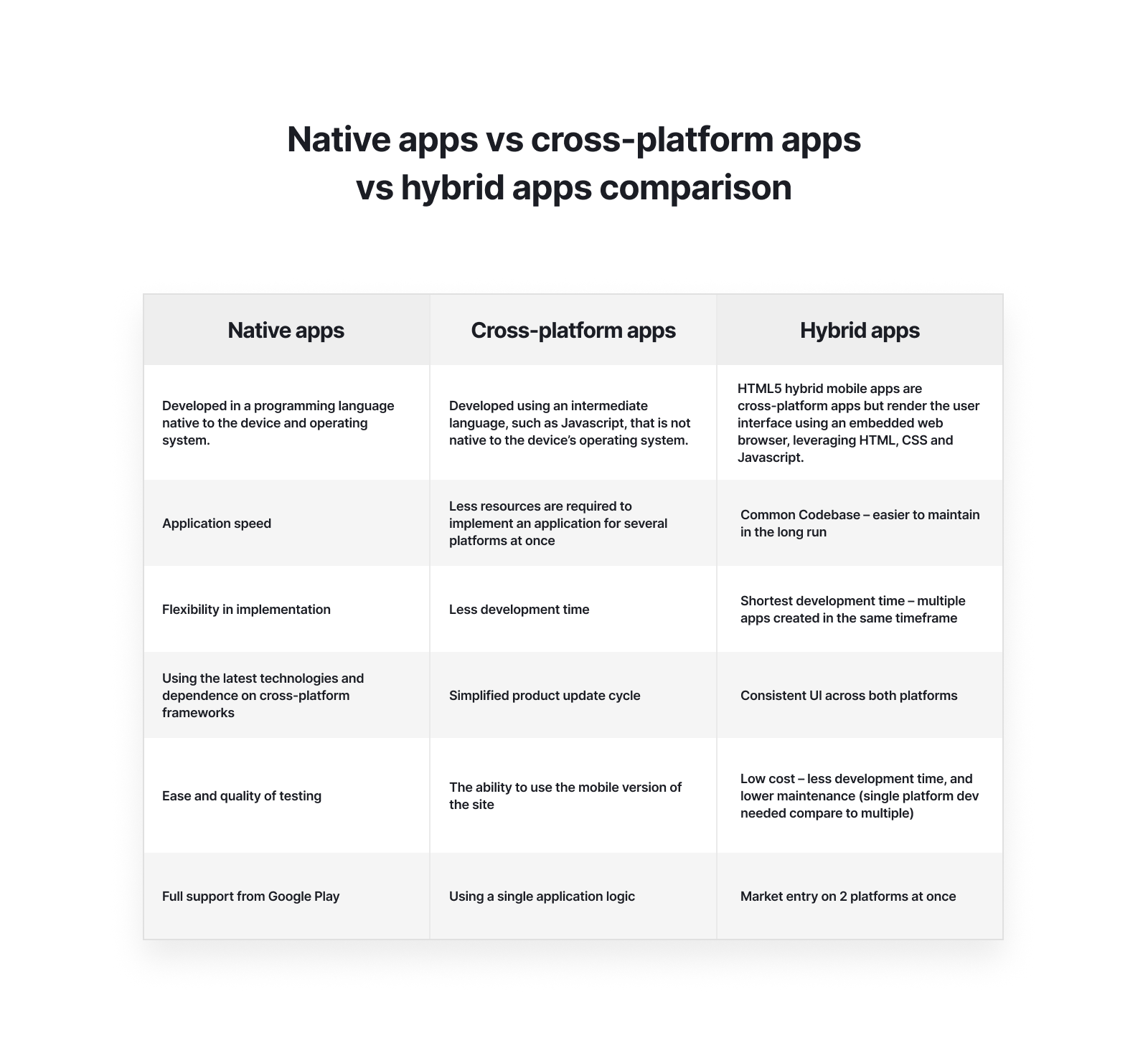
From a technical point of view and from the point of view of the quality of the interface, the native technology for developing mobile applications has much more to offer. Nevertheless, there are areas in which cross-platform technologies are justified: the gaming sector and test projects.
The vast majority of modern games are written using cross-platform technologies. This dramatically speeds up development without sacrificing quality. In this case, special graphics frameworks are used (the most popular is Unity 3D).
If a project has to be done quickly to carry out tests, and the situation requires the project to work on several platforms at the same time, a cross-platform implementation may be the best solution.
If the project is not a game project, is aimed at long-term development, and requires a positive user experience, then it would be more rational to create a mobile application using native tools. Once the development method has been chosen, it is time to discuss the cost of developing the application.
05 Pros and cons of Android development
Mobile app development is not cheap, and there are the drawbacks to apps. But with a well-thought-out professional approach, it pays off quickly and has significant advantages over even an adapted or responsive website.
Let's take a closer look at the pros and cons of Android.
Advantages of Android
Better than a website/Ideal for smartphones
If you have ever tried to access a store website from your smartphone, you immediately see how inconvenient it is to use. Very small font, pages do not fit on the screen. You have to zoom in and out on the page, getting lost from time to time.
Meanwhile, the mobile app is fully adapted to the smartphone screen's size — this is the main benefit of the application for the client. Moreover, some functions will only work on a mobile device (for example, push notifications, calls, geolocation).
Here Android application development would be the best choice. Check out 15 Android Mobile App Development Trends No Company Can Miss In 2021 to be sure.
Marketing channel #1
The lion’s share of internet visitors are using mobile phones. And if a person installs your app on their smartphone, then they are definitely interested in buying your goods/services.
Besides, given that most of the population uses Android, you have a better chance of getting most of your present client base to use the new app.
Payment via Google Pay
Today, all payment data can be stored on a smartphone without fear of theft. When your device has a fingerprint sensor, lock code, or pattern, losing your bank card becomes a bigger problem than losing your phone. The user can make a purchase in one click through the mobile application, usually without entering a card number, expiration date, and CVV code. This is especially important when the card is not at hand or the matter is very urgent.
Improving SEO performance
Until a few years ago, when issuing results for search queries, Google only took the sites' indexing into account without considering the content of mobile applications.
Today, the situation has changed radically. With the help of an app developed on Android OS, you can enable application indexing. Users will then receive information about your application's services even if they have not installed it yet.
For example, a person searches for information about an inexpensive taxi from a browser. An advertisement for your application appears on the page, offering a discount on the trip.
According to data from 2016, only 30% of application owners used their indexing. So, with the right approach, your business can get far ahead of the competition.
Knowledge of the user’s location
This data is not only valuable for audience analysis, but it’s also a tool that helps users. For example, by knowing the location, you can offer the user the addresses of the nearest coffee shops, bank branches, the nearest store warehouses where they can pick up the goods, or company offices.
For example, Starbucks shows the nearest outlets' addresses and suggests ordering coffee in advance so as not to wait in line.
Using WebView
Business owners have the ability to redirect a client to an application from a site and vice versa. For example, a person is looking for a phone, clicks on it on your store website. The customer is invited to go to the company's application, to which they already have an electronic wallet attached.
The client not only makes a purchase easily if they found what they were looking for, but will also most likely remain in the application if they decide to continue the search. Thus, you reduce competition from other companies and don’t lose the client to search engines.
Multitasking
Multitasking is well implemented in the system when several applications work simultaneously without problems.
Even on a less powerful device, several browser tabs, a music player, and some resource-intensive applications can work effectively at once. Switching between tasks is fast.
Operational updates
Google is constantly working on improving the operating system's functionality, fixing bugs, and making changes to the interface.
Independent developers also put a lot of effort into improving their applications, quickly adapting them to new OS versions.
Application price (for buyers)
Many apps on Google Play are cheap or completely free, unlike the App Store, since they are cheaper to develop.
Availability
Android is available for devices from different manufacturers and brands, and there are no restrictions here.
Disadvantages of Android
Cost
Despite the fact that developing an Android application is cheaper than iOS, it still costs money. Moreover, if you decide to have support both (IOS and Android), remember that the implementation and promotion will be an additional cost.
Before developing an application, consider your goals well. You should not develop an app just because "others have." It is important that the application solves specific problems.
Increased competition
According to Google, the "era of applications" is coming, and their number is increasing every year. Unfortunately, this increases competition for customer attention.
Plus, don't forget that there are more Android users, which leads to a greater quantity of related apps. On top of that, the relative ease of passing the Google Play approval process means competitors are looking at Android app development as well.
Compatibility
Ensuring that a native application functions properly depends on the specific operating system requirements. This means that each platform (iOS, Android, Windows) needs a separate working version of the program.
Support, service
It is necessary to provide regular updates, and fix compatibility problems with each type of device. In addition, users should always be reminded to install new updates.
System openness
Android is an open system that can be easily installed on almost any device with any hardware, and easily hacked, copied, and reinstalled, which is why it has low stability.
iOS versions, on the other hand, are based on a closed source operating system, which means that the source code cannot be downloaded and is difficult to hack.
The bottom line
Despite all its shortcomings, the Android operating system has been and will be in demand in the mobile device market. The main reason is its loyalty to users.
A wide range of devices running Android covers all price segments — both budget models and premium class, allowing almost everyone to get a device with an operating system from Google.
Hence, the decision is up to you.
06 Android: features, integrations, and APIs
Android can do a lot, but as with any operating system, you need to know where to start. And this is not the only reason to study the features in detail. Compared to the rigid preferences of the iPhone interface, Android gives you more customization and control. To whet your appetite, let's take a look at the basic functions that you should be familiar with.
However, to be clear, we’re considering Android's and Google's features separately. This is important due to the Huawei and possible Xiaomi ban.
Note: This means that Huawei no longer has access to the very fundamentals of Android smartphones, Gmail, YouTube, Google Drive, and even the Google Play Store itself are no longer available for Huawei to use on new products.
Android features:
Camera
The Android platform includes support for a variety of cameras and camera functions available on devices, allowing you to capture images and videos in applications.
Before allowing your app to use cameras on Android-powered devices, you should consider how your application intends to use this hardware feature.
- Camera requirements. Is using the camera so important to your app that you don't want your app installed on a device that doesn't have a camera? In this case, you must specify the camera requirement in your description.
- Quick Picture or Customized Camera. How will your app use the camera? Are you just interested in taking a quick photo or video clip, or will your application provide a new way to use the camera?
- Foreground service requirements. When does your application interact with the camera? For instance, on Android 9 (API level 28) and later, apps running in the background cannot access the camera. Hence, it would help if you used the camera either when your application is in the foreground or as a component of a foreground service.
- Storage. Are the images or videos generated by your app intended to be viewed only within your app or shared so that other apps like Gallery or other media and social apps can use them? Do you want images and videos to be available even if your app has been removed?
Bluetooth
The Android OS includes support for the Bluetooth networking stack, which allows the device to communicate wirelessly with other Bluetooth devices. The app platform provides access to Bluetooth functionality via the Android Bluetooth API.
Using the Bluetooth API, an Android application can do the following:
- Searching for other Bluetooth devices
- Request a local Bluetooth adapter for paired Bluetooth devices
- Install RFCOMM channels
- Connect to other devices through service discovery
- Transfer data to and from other devices
- Multiple Connection Management
Contacts integration
The Contacts application is one of the most important on your Android device. We add new data about our acquaintances almost every day (and sometimes social services even synchronize and replenish them for us), introducing more and more chaos into the address book.
Android offers you some help in your contacts. We will look at how to organize your contact list with tools built into the operating system.
The Contacts feature gives you instant access to all the contacts associated with your Google account. To get started, you can use the "Favorites" tab. Here, you can add people with whom you communicate most often, for example, family members. To do this, select the desired contact, go to its settings and find the "Add to favorites" option.
Another way to clean up your notebook is to customize your contacts. In the app, click the "More" button and select "Contacts." The next screen allows you to select which contacts are shown in the application and which are hidden from view. Thus, you will not lose subscribers with whom you rarely communicate, but at the same time, they will not clutter the general list.
NFC
Near Field Communication (NFC) is a collection of short-range wireless technologies that typically require a distance of 4 cm or less to establish a connection. NFC allows small amounts of data to be exchanged between an NFC tag and an Android device or between two Android devices.
Android devices with NFC support three main modes of operation simultaneously:
- Read / Write mode that allows an NFC device to read and/or write passive NFC tags and stickers.
- P2P mode that allows an NFC device to communicate with other NFC peers. This mode of operation is used by Android Beam.
- A card emulation mode that allows the NFC device to act as an NFC card. The emulated NFC card can then be accessed using an external NFC reader, such as an NFC terminal at a point of sale.
Biometrics
Using complex passwords is a very reliable way to protect a user's online identity. However, passwords are usually too long and difficult to remember, and require regular updates. Two-factor authentication also enhances user security, but it can take up valuable time and can cause problems for international travelers.
In connection with all of the above, Google, together with the FIDO Alliance consortium, has implemented support for biometric authentication in its services. From a security standpoint, biometric authentication is stronger than passwords and two-factor authentication since biometric data is much more difficult to steal or reproduce. The biometric authentication process is performed locally on the device, and no confidential information is transferred to applications and services in which the user is authorized.
Biometric factors provide secure authentication on the Android platform, with support for biometric face and fingerprint authentication. Android can be configured to support other forms of biometric authentication (such as iris). All biometric implementations must meet safety specifications and be highly rated to participate in the BiometricPrompt class.
UI libraries
Mobile apps are becoming less static. Interface animation is becoming an integral part of modern applications, making them more user-friendly and easier to navigate.
Android projects can use animation for several purposes, in particular:
- to display the status of the application, as the user will be pleased to receive a response to the actions they perform. In addition, the corresponding animation will brighten the user's expectations when updating the page content;
- to connect different phases of a process, providing a smooth transition between phases and seamless user interaction;
- to embed new elements, fitting them into the content harmoniously;
- to simplify the process of interaction by informing the user about what he/she is experiencing at the moment.
Animations serve to enhance user actions. However, bizarre or complex effects are distracting and confusing. So, developers must always maintain a clean environment.
The more you know regarding animation UI / UX libraries for the Android OS, the easier it is for you to use them intelligently. Otherwise, you can hire Top UX/UI and Mobile App Designers. Also, don't forget to read our blogpost - WOW Your Users With These 31 UX Best Practices for Mobile Design.
Google features:
Google Maps
This is one of the most recognizable Google APIs for Android. Google Maps is a suite of applications built on a free mapping service and technology used by Google. This application is used to search for information on a map with marks for attractions, organizations, etc.
The service offers such display modes as:
- Satellite - displaying satellite and aerial photographs (this includes "Object names" - displaying information on diagrams. Before that, the mode was called "Hybrid");
- Map - showing cartographic data;
- Terrain - diagrams that display massive surface features such as forests or hills (false 3D relief);
- Street View - a mode that allows you to navigate through panoramic photographs against the background of city streets;
- Personal view - a personalized mode that allows you to map the content you want.
Thanks to the Android maps API, the user can:
- view interesting locations on the map;
- open files with the KML and KMZ extensions, as well as save the necessary labels in these formats;
- plan a route;
- add personal text, pictures, and videos;
- send the created view to friends.
Some modes and functions are as follows:
Google Transit mode provides detailed directions on how to travel between two specified points on available public transport and gives an estimate of how long it will take.
The user can send a link with their location to the mailbox or place the HTML code for the Google Map on a web resource. Also, in Google Maps, there is a tool for generating a map for printing.
Integrated search results for information on organizations — search for addresses of companies and their contact details in the selected area. For example, if you write the query "sushi in the *name* area," it will show the nearest sushi restaurants, their addresses, and hours of operation. You can also view additional information such as payment methods, ratings, customer reviews, etc.
The Map Maker function is available in maps (previously, it was a separate service), which allows you to change the content with your own information.
Google Assistant
Google Assistant was launched in 2016. It was originally supposed to be available for smartphones developed by Google itself, namely the Google Pixel. But such a great idea and implementation of a voice assistant could not live in such a limited space for long. So, Google Assistant was added to other smartphones.
But do not assume Google's voice assistant is only available for smartphones running Android.If you go to the App Store on your iPhone, you can also use it. Are you ready to give up Siri and trust Google Assistant entirely? Hmm ... that is something to think about. But, of course,it isn’t limited to smartphones, it is also included in tablets, which is no less convenient.
Recently, smartwatches have become an excellent addition to our smartphones. This is a great tool that helps us manage some processes without having to take a smartphone out of our pocket. We can see who is calling or read a message using a smartwatch, switch music, or like an Instagram post. But there are often times when we would like to do all this, but our hands are busy. That’s when Google Assistant comes to the rescue on a smartwatch. It quickly recognizes the user’s voice and performs all these operations with voice commands. It's very convenient!
Google Pay
Google's answer to Apple Pay is Google Pay for Android users.
With the release of Android M in the fall of 2015, the Android Pay payment service was launched in the United States. It was later renamed Google Pay.
Google Pay allows you to easily pay for purchases with your Android smartphone in stores, on the web, or in mobile apps.
In a regular store at the checkout, you can simply touch your smartphone to the payment terminal, and your purchase will be paid for — no cash, no plastic card, or PIN code. However, if you make more than three transactions for more than a particular amount, you will have to unlock your phone to approve the payment.
Push notifications
In addition to Android's ability to support "push" services, which displays data as it arrives rather than waiting for you to ask for it, there is a notification area for incoming information.
This allows you to have all the news literally "at your fingertips," no matter what you are doing at the moment.
Notifications can come from a wide variety of locations, from an email client, voicemail, text messaging service, social media, and news apps. When you receive a new notification, an icon will appear in the upper left corner of the screen. You can pull down the panel to see the details of the notification and then take action if you want.
Check the settings of the various apps that are installed on your device to see what notifications they offer, then set them up to work the way you want.
Play Store
Play Store is a very useful service. It is a "branded" online store. All programs presented in it are divided into several categories ("Applications", "Games", "Music", "Books", etc.), each of which has its own subclassification (by genre, style, direction, etc.).
Play Store products are mostly free, while the cost of paid programs is quite low. All Android smartphone users can use the Play Store app.
Using the Play Store opens up additional capabilities of smartphones that seem incredible at first glance (for example, using a smartphone as a webcam or barcode scanner).
The app account is needed to:
- Access over 1.5 million apps written specifically for Android.
- Access all Google-powered services (from a virtual flash drive and online documents to mail and maps).
- Sync bookmarks and notes across all your Android devices (smartphone, tablet, etc.).
- Synchronize contacts and access them from all Android devices.
- Obviously, the application's capabilities are quite extensive, but they can only be used after registering with the service.
After selecting an application (simple touch), its description will open. Then tap "Install", and upon completing the installation, open it. When installing, you need to pay attention to the permissions that the application requests. Despite the fact that the Play Store monitors the safety of the apps offered, you can stumble across a program with a virus or an application that reads the user’s SMS or personal information.
If a paid download is performed, the money will be automatically debited from the card linked to the account. If a card is not connected, paid applications cannot be downloaded.
The Bottom Line
As you can see, the list of Android features, integrations, and APIs is quite broad. Even if the desired integration doesn't exist or doesn't work the way you want it to, stay calm. The great advantage of Android app development is that every native, official feature has an unofficial alternative.
Be sure that your product will have all the functions you can imagine.
All you need is just to hire Top API Developers.
07 Building an Android app - development process and costs
Did you know that about 6,140 mobile apps are released on Google Play every day? Statistics say one thing — it's time to develop your own Android application. If you are seriously thinking about creating an application, our Android programming guidelines will help you.
How is an Android app developed? That is the question that clients ask us most often. They want to know how much time and money it will take from them, how the work is structured, where to start, and how to earn rather than lose as a result.
This vital question, which cannot be answered in a nutshell, inspired us to publish this chapter. There will be no vague tips from a "how to develop an Android app: three easy steps" series. Instead, we will share the experience we have accumulated over more than seven years of work in the mobile development market.
It doesn't matter if you plan to create a tool for a business or a startup with a broad audience. We will dispel your fears and describe the stages of developing a mobile application.
In previous articles, we told you:
- eCommerce Mobile App Development Cost - What You Need To Remember
- How To Estimate Mobile App Development Cost [Project Manager's Guide]
Now, let's talk about creating an app for Android, how the work is structured, what the analysis stage includes, and what should be the terms of reference.
So, here is the play, "How to make an Android app" in eight acts.
Note: The development of Android applications is a complicated and very laborious process. It is full-fledged software development. To make it easier for you to understand how we create mobile applications, we will briefly tell you about each stage of our work.
Pre-Development Phase
-
Ideation / core idea development
Every application starts with an idea. People come to our company to implement their vision of a mobile app, web-resource, or to automate business processes. You tell us what tasks the future Android app should solve, and we start collecting data: a deep cut of the market, analysis of existing solutions, a study of competitors, and customer behavior patterns. We keep the end user in mind at each stage of the research, think about the customer's life cycle.
We conduct a free business examination, advise the client, and refine the project's conceptual component, taking into account the users’ demands.
This helps us understand how people will use the new application and helps make it as user-friendly, understandable, and useful as possible. -
Creating an application development strategy
We compile a detailed development strategy for the future application. We define user characteristics, describe user stories, draw up a customer journey map, and formulate the service's technical requirements. That is, we determine what the application should be like, what it should be able to do and how it will work.
With such a technical assignment (TOR), our team of designers and developers clearly understands what kind of service the customer wants to receive, then we gradually implement the initial idea.
Each development studio has its own approach to compiling this strategy. We believe that for a successful project implementation, the following should be reflected:
- General information
- the purpose of creating the app;
- development options: native, cross-platform, or hybrid app;
- scalability: is the application able to quickly adapt to sudden changes and peak loads? For example, to an increase in the number of users or the volume of data transfer;
- fault-tolerance: whether the application should continue to work if one or more of its components fail. - Functional requirements for the application:
- user roles: what should the access levels be for different users, for example, a guest and an authorized user;
- data formats: how the data exchange will be implemented in the application;
- integration: should the application support interoperability with other services, such as payment systems and mail servers?
- access interfaces: how the application will exchange data with external services;
- additional functions: should the application be able to do something else? For example, work with files or encryption libraries;
- configuration and administration: what elements the administrator will use to manage the application;
- system composition: what the mobile application consists of, that is, screens, push notifications, and authentication system, etc. - Non-functional application
- security: requirements for the protection of the application;
- logging: does the system need to generate and save reports on errors that occurred during the operation of the application? If so, for what types of events should this be done?
- performance: requirements for the application, such as the speed of the database;
- server hardware requirements: list of technical specifications - Implementation of application functionality:
- loading screen
- registration and authorization
- main screen
- menu
- search
- notifications
Thanks to a competently drafted technical strategy, our team of designers and developers will clearly understand what service the customer wants to receive and gradually implement the initial idea.
- General information
-
Wireframing
With an understanding of what users expect from the application, we proceed to the wireframing process. A well-built interface is a guarantee that the user will quickly figure out how the application will help solve their problem.
You get the opportunity to see the functionality of the future application without the software part. -
The application design and UX/UI design
Sometimes clients come with a ready-made layout. If the customer does not have a design, our UX/UI Designers build it from scratch. We start visual design after the analyst gives the designer the basis of the graphical interface, the wireframes. We draw a map of screens, a detailed prototype, and graphic elements, taking various use cases into account.
At this degree, the UI/UX designer produces static prototypes and, at the client's request, interactive prototypes of the app. This is how we show what the app will look like and what behavior to expect from it, taking the proposed features into account. It all depends on the precise tasks and wishes of the customer.
During the design drawing, the application gets its future appearance. It is essential to get feedback from the business analyst and the client so that the design fully meets the application's requirements.
Note: Conducting workshops with the client, especially in the early stages of development, is the most crucial part of the pre-development/development phase of any project.Development Phase
-
Coding
When there is a detailed technical strategy, the design is ready, and the mobile application prototype is approved, the core stage begins. The development group writes code to implement the application's intended behavior and connect the application logic to the back-end if provided. We also create the finished design in the code - we handle all the styles as well as the UI elements the user .
As soon as part of the functionality is developed, we test it and continue to work on the rest of the functions.
It is essential to involve the designer during development, when the design is laid out. They will check how well the devs have implemented the wireframes of the app: whether all the styles correspond to the ones chosen, whether the desired color is used, what the aspect ratio is, how the corners are rounded, etc. -
Testing: both automated (CI/CD) and manual
Ideamotive QA engineers are connected to the project from the very start and conduct tests as often as possible. This ensures a high level of quality which helps keep the project on budget.
At the assessment stage, we test the technical specification.We create test documentation in parallel with the development. For instance, test cases. When part of the functionality is done, testing (both automated (CI/CD) and manual) begins.
Our devs add all bugs to the bug reporting system. After fixing them, we check to ensure everything works fine, and that the bug fixes did not affect the rest of the functionality.
Before the application's deployment, we do acceptance testing: we go through the main business cases of the application to make sure that the application's behavior meets the test documentation and the client's requirements.Post-Development Phase
-
Deployment
When a series of tests and application modifications are completed, and developers, analysts, testers, and designers agree with the result, it is time to add the application to the Google Play store or any other service the client requests.
In order for the application to pass the store's review, the client can contact the developers for help with the release, or they can prepare and publish the application to the store on their own. -
Updates and new releases (ongoing)
The story doesn’t end with the publication of an Android application. If the customer finds bugs after the release, we fix them.
If the first months of the app's life show where and what needs to be finished or redone, there are two options: conclude a maintenance contract or start a new development phase taking new information into account.
Mobile app development is not easy. Many stages can cross with each other or run in parallel. It took Instagram over three years to become a user-friendly and favorite app for millions. And they keep improving and adding new features.
Before you fantasize about what you will invest in selling your app to an IT giant like Google, brace yourself — there is a lot of work ahead.
But what about the cost of hiring an Android app developer?
Let's discuss this question in detail!
How much does Android app development cost
The first question that the client asks is: "How much will it cost?" As well as, "How long does it take to develop an Android app?" To answer both questions, Ideamotive evaluates and draws up a work plan.
At this stage, the project manager (PM) usually joins the process. They can act from the side of the customer or from the side of the development team. The project manager’s tasks include:
- coordinating the group’s work;
- communicating with the customer.
But what does the cryptic word "evaluate" mean? At this stage, we study the technical documentation. We calculate how long it will take for development and testing. We identify scenarios and bottlenecks in the requirements.
The express assessment takes several hours to one day and gives a rough idea of the labor costs. A detailed review can last from a few days to a week, but it allows you to accurately determine how, when and which application you will receive as a result.
Suppose the business analyst comes into the project during the evaluation phase. In that case, it is easier for the client and developers to get a singular view of the application and calculate everything accurately.
But no matter how detailed the pre-invoice is, customers often add new features during the project. The list of tasks may increase. In that case, we would re-evaluate and move the release date.
As a result, the budget would grow.
According to various sources, the cost of developing professional mobile applications can range from a modest $ 5,000 to an incredible $ 500,000.
To see the price formulation process in more detail, please find some time to read How To Estimate Mobile App Development Cost [Project Manager's Guide].
08 Hiring Android Developers - What Should You Keep In Mind?
Like hiring any member of your team, looking for Android developers is a long and complex process. With a very small number of experts available in the local market, a limited project budget, and the need to scale here and now, this seems like an "impossible mission."
But let's look at everything in order.
Overview of the global market of Android developers
According to Stack Overflow Developer Survey 2020. the overall share of Android devs is 26.2%
Do a quick search for Android jobs on LinkedIn, and you'll see over 110,000 results.
While Android has been around for over a decade and the OS seems to have reached a certain level of maturity, the job market is not slowing down. There are many more companies looking for qualified Android developers.
So, if you want to create apps that work on Android devices, hurry up to hire an Android app developer.
But where do you find one?
There are good candidates in the US, EU, and CEE. According to Statista, the distribution of Android app developers worldwide by country is: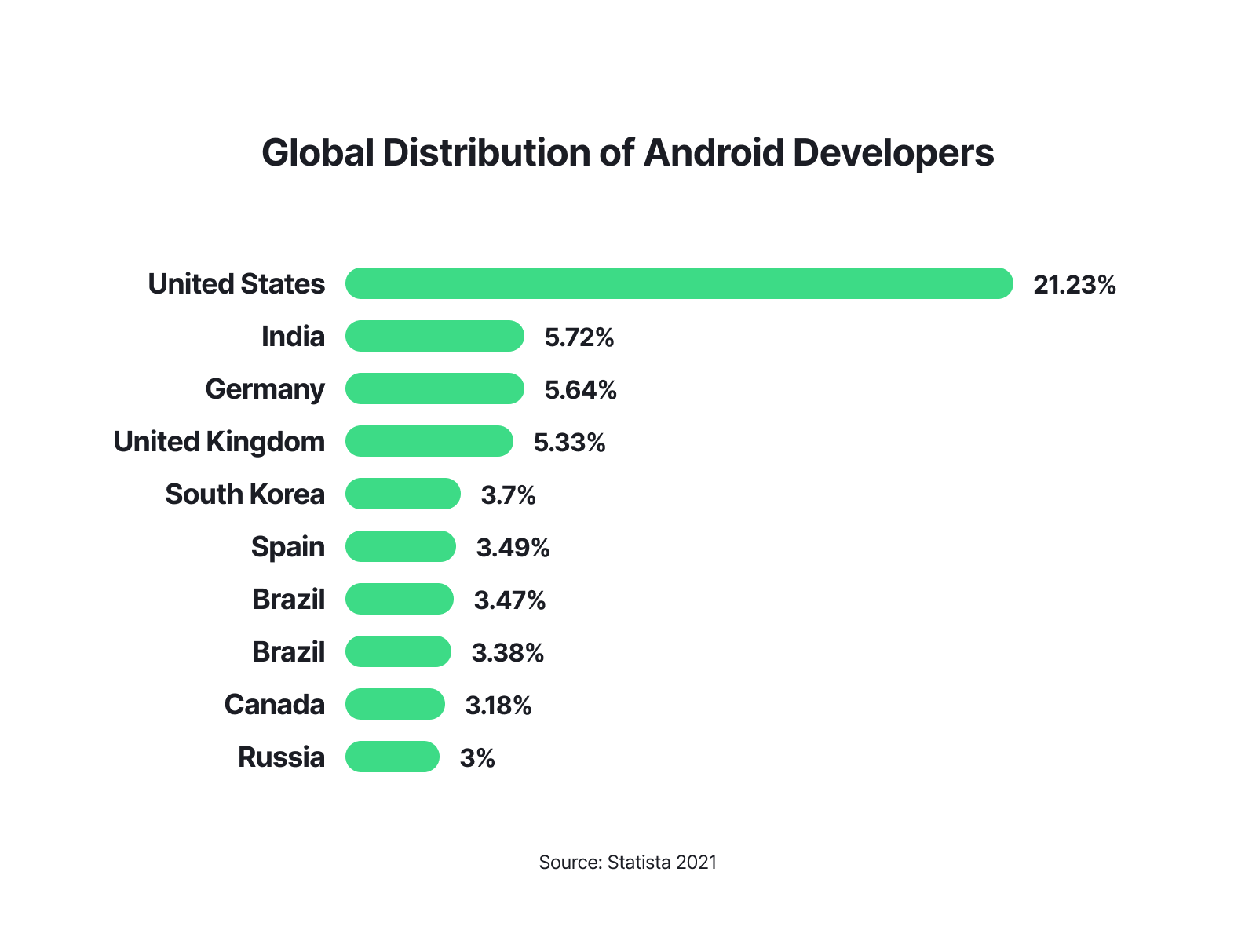
Android developer salaries depend on the person’s individual skill level (junior, middle, or senior), their professional experience, country of residence, the company, and so on.
To illustrate how much Android app developers earn, let's compare Android developer salaries in three different regions ‒ CEE, Western Europe (the Netherlands), and the United States.
Disclaimer: The numbers shown below are just an estimate and may vary based on the aforementioned factors.
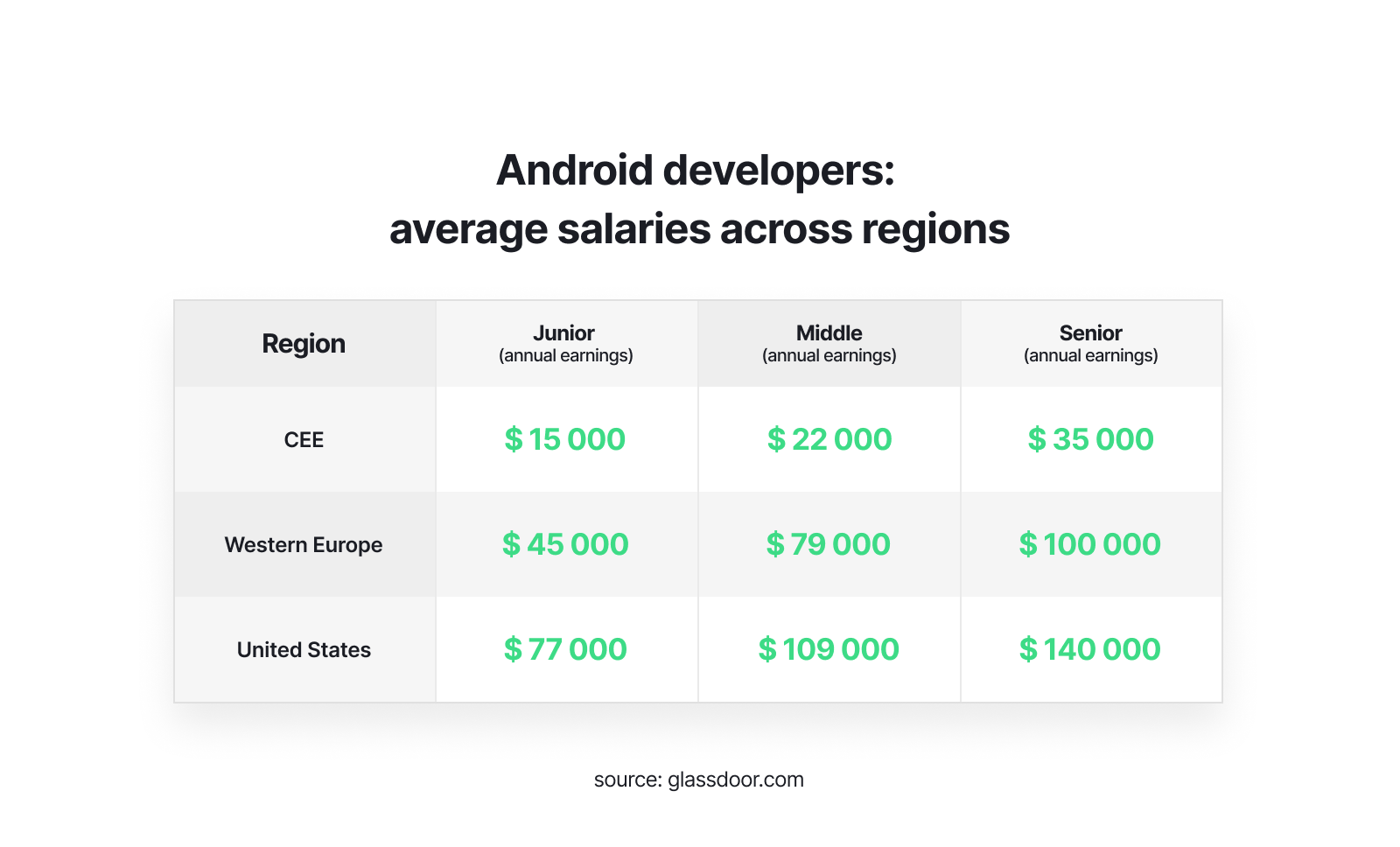
A question arises: "The cost to hire an Android application developer in the US is higher due to their skills and experience, isn't it?"
Not at all!
Hiring Android devs from Central and Eastern Europe is as reliable as hiring in-house ones.
They've got the same qualification level, which is even higher in some areas. The only difference here is that this employee wouldn't be your next-door neighbor.
Still, let's see other options!
Where to hire Android app developers
In-house hire and development
The first option is to hire an in-house app developer. Based on the project, you may find that one employee is not enough. The app development team usually consists of 5-7 professionals, such as a QA engineer, project manager, Android app developers, a backend developer (server-side), and a UX / UI designer to cover all areas required to develop a great app.
While choosing this strategy, keep in mind that in the current talent-driven hiring environment finding thoroughly vetted talent is tough for recruitment managers. Especially when it comes to filling software development-related positions, you might experience difficulty.
Due to the heavy competition, you need to put your best foot forward and arm yourself with a really compelling offer emphasizing, in particular, your company culture, incentives and benefits, career advancement opportunities, and a competitive compensation package.
If you decide to hire developers in-house, you have to take into account high wages (in the United States senior mobile developer earns on average up to $180.000 per year, meanwhile in the United Kingdom up to $110.000), as well as much smaller talent pool in your city or even in the whole country, compared to the global forces. It is recommended then to expand your talent search to other thriving parts of the world - just in the CEE region you can find over 1 million tech experts.
The recruitment process itself can be toilsome and labor-intensive when managed in-house. Be prepared for the time-consuming and costly advertisements, cooperation with the HR department, or in some cases for hiring an experienced headhunter who will make use of his/her own network, and is equipped with the market expertise.
The second case where hiring a full-time programmer is often required is when you run a software development company. Again, this would be a large company or group of companies with its own product, with a staff of programmers, testers, and analysts. They have a secret product or a unique service, and they spend all day and night on it, providing the whole team with work.
You will benefit from having complete control over the application development process, and you can maintain close daily communication and collaboration.
Pros
- Good communication.
- Easy to maintain corporate culture.
- Slow internet isn't an issue for your workflow.
- No difference in time zones.
Cons
- Requires full-time salary.
- Requires full employment.
- Additional costs for office space, equipment, and taxes.
- Organizing personnel procedures and the development process itself.
- By and large, it is overpaying for physical presence.
Freelance platforms
Hiring freelance contractors is the best way for many companies. If the company is small,the tasks are periodic, during reporting or during the transition from version to version of a software product, to release updates, or for one-time consultations, freelancers are suitable.
Some of the most popular platforms for this are Upwork, YouTeam, Freelancer.com, and Fiverr.
In short, they are all the same. This is how they work:
- You go to a website,
- Set up your "client" account,
- Create a job,
- Wait for candidates to send you their job applications,
- Hire an Android developer online,
- Discuss how you are going to work together with your preferred developers.
Pros
- Lower rates.
- Large personnel reserve.
- Previous customer reviews are available.
- Very well suited for short-term projects or making small changes to existing ones.
Cons
- No quality guarantees.
- Your only defense is platform policy.
- Different time zones.
- Possible language barrier.
- You have to manage everything yourself.
Hiring an external mobile development company
Along with the global IT market's growth, many development firms have emerged. These teams usually provide low-cost application development services.
How do they do it? Most of these companies underpay their employees and use newcomers or recent graduates as cheap application developers.
It’s not a guarantee that your app will be below quality, but let’s be honest, choosing this option will limit you to the employees who currently work for that company.
Hence, you never know which specialist has worked on, for example, your project’s wireframing, whether it was a highly-experienced person or a rookie coder.
The other drawback is that many software agencies are built around one or few software development technologies, e.g. React Native or Java. That means that they are often limited when it comes to proposing technological solutions to their clients.
Pros
- Lower price.
- No additional costs.
- You get the app.
Cons
- No guarantee of quality.
- Limited in terms of techstack choice.
- Limited in terms of picking the dev team.
Outsourcing developers matched with your project from a vetted marketplace
Last, but not least, you can reach out to a dedicated development team like Ideamotive and Toptal. Such firms provide full-fledged services, from the completion of the application design concept to the release of the application and further support and maintenance.
That being said, depending on the region, these teams can provide very good value for the money. For example, Eastern Europe is well known for its highly skilled mobile application developers. The hourly rate of hiring an application developer in, say, Poland is about $30-50 per hour, which means that the average price for an application project will start at about $50,000.
Moreover, these firms usually have a long history and years of experience in outsourcing application development with developers who are full-time employees. Due to fierce competition, they value their reputation, brand, and customers.
Ideamotive is a specialized web and mobile app development agency that has been providing software development services since 2014. We definitely know how to achieve our customers' goals and provide high-quality products to end-users.
A good outsourcing company can provide all the specialists: analysts, programmers, consultants, and project managers.
Finding one head that holds everything is very difficult and unnecessary. After all, a narrow specialist will find a solution in minutes, and a full-time employee can figure it out for hours and sometimes even days, wasting the company's time and money.
Pros
- Getting benefits from business processes without managing them. The important functions are transferred to contractors. Therefore, the result is achieved through external efforts.
- Attracting competent professionals. Outsourcers are professionals in their field. Therefore, they perform highly specialized tasks like no one else.
- Savings on labor resources. Since certain business processes are transferred to a partner, the company does not need to maintain its own employees to handle them.
- Saving money. Downsizing leads to a decrease in the total payroll. This, in turn, reduces the social security contributions cost and tax payments.
- Increase in the efficiency of core activities. Getting rid of non-core functions means getting the opportunity to concentrate on the main direction and increase its effectiveness.
- Maintaining the legal status of the company. If you do not hire employees on staff, but replace them with contractors, then the company meets the requirements of a small business, even when a large number of people actually work for it.
- Lack of expenses for personnel records management. The outsourcer independently selects personnel. Therefore, the client can be sure that the business processes are carried out by professionals.
- Lack of formal labor relations with specialists. Although accountants, lawyers, and other employees serve the client company, they officially work for the contractor.
- Eliminate disputes and disagreements with staff. If a specialist is dissatisfied with something, they can only complain to their employer. The client pays the agency for services and is not involved in personnel management.
- Eliminate problems with government services. Regular staff checks don't affect the company in any way. Employees are officially registered in another organization.
- The contractual form of relations. The partnership between the contractor and the customer is formalized by an agreement. It prescribes all the obligations and responsibilities of the parties, as well as important nuances of cooperation.
- Payment for the result. A full-time employee can simply sit out the time "from call to call," doing a minimum of work. An out-staffer receives a fee only for a specific result.
- Service versatility. Any non-core functions can be moved under external control. Accounting, legal activities, cleaning, logistics services, personnel records management — an entrepreneur can trust partners with any tasks if they are sure of receiving benefits.
Cons
- It is difficult to maintain corporate culture.
- Different time zones.
- Dependence on outsourced performers.
How to hire an Android developer
Skills required for an Android application developer
You may be looking for someone to customize the little things or manage the entire development process. Depending on your needs, you can hire Android developers with different skill levels — junior, middle, or senior.
Junior Android Developer
- less than 3 years of work experience;
- develops simple applications;
- can work as a middle and senior developers' assistant.
Middle Android Developer
- 3+ years of experience;
- deals with complex projects based on Android;
- can work independently.
Senior Android Developer
- 5+ years of experience;
- leads, supervises, and advises large projects;
- takes the position of the team leader.
Whether it's a beginner junior or a seasoned senior, an Android developer must have solid technical knowledge, problem-solving, and teamwork skills, and that's the bare minimum.
Android developer hard skills
Let's start with the technical side. The minimum set of your Android app developer skills:
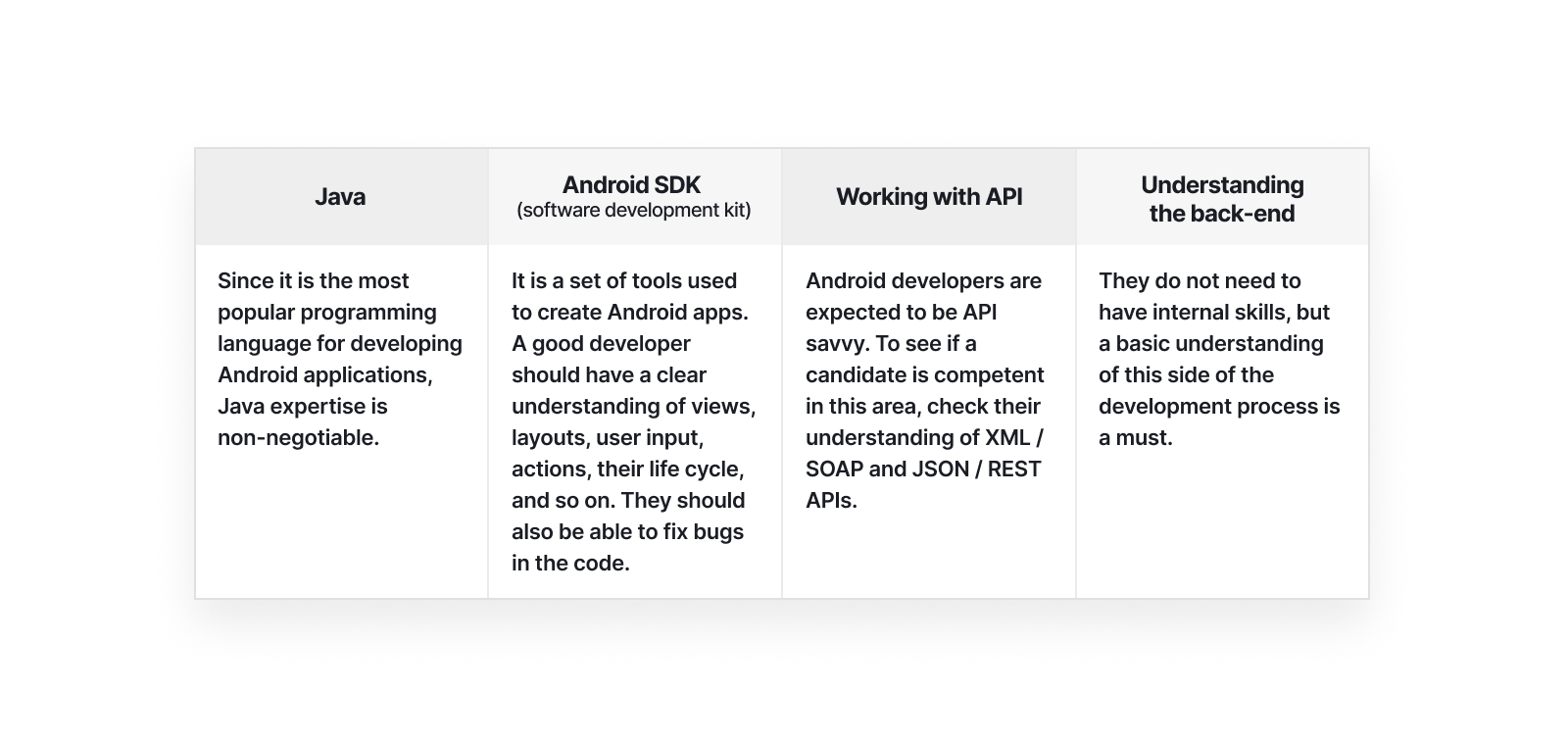
Android application developer soft skills
In terms of interpersonal qualities, here's what to expect from a candidate: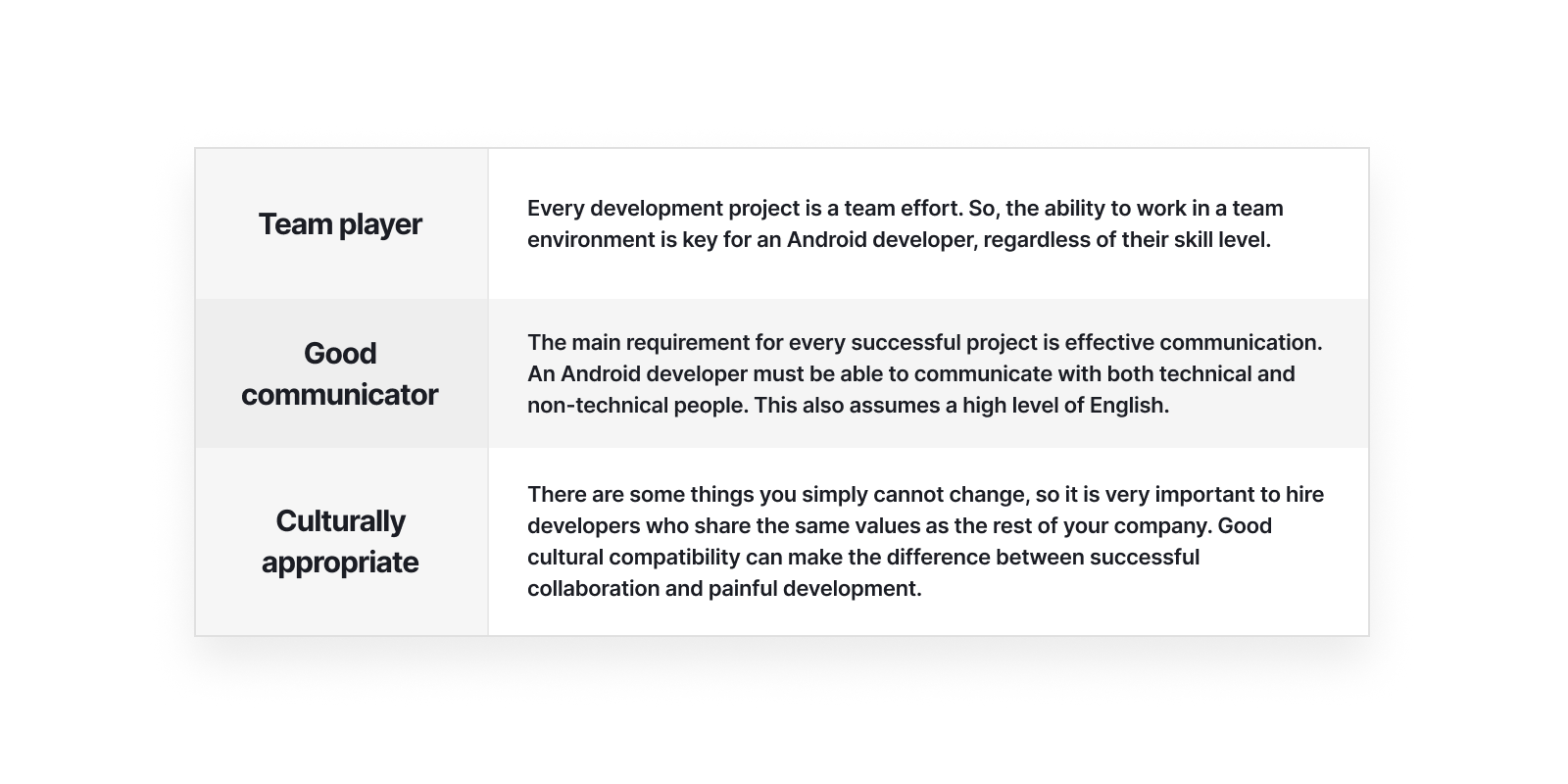
How to interview an Android developer?
Tou will start receiving applications soon. The next step to hiring a remote Android developer will be to select the most qualified candidates and lead them through several rounds of interviews: a hard skills interview to test their technical knowledge and a soft skills interview to see how good they are at problem-solving, communication, and other important aspects of teamwork.
Hard skills interview questions
- What are the benefits of the Android operating system?
- Could you briefly explain the architecture of the Android / Android Framework?
- What components are required for a new Android project?
- Could you briefly explain what "Services"/" Activities" are?
- Please explain the lifecycle of an activity.
- What are Implicit and Explicit Intentions?
- What tools are used for debugging on the Android platform?
- How do you troubleshoot common Android app crashes?
- How do you detect memory leaks in an Android application?
- Can you name any mobile automation tools available on the market?
Soft skills interview questions
- Why are you applying for the position of Android developer at our company?
- What are your professional strengths and weaknesses?
- Please describe the most interesting Android app development projects you have participated in.
- Can you recall a decision you made for an Android app development project that turned out to be a mistake? What did you learn from this experience?
- Do you enjoy being involved in analysis, design, and deployment, or do you prefer to focus solely on completing a specific task?
09 Examples of Android use in the wild. World-class Android apps
The Google Play Store is developing at a tremendous speed. A few years ago, it was far behind the Apple App Store in terms of the quality of apps, and it was very difficult to find something really useful among the huge number.
Today, things are much better. In this chapter, we'll look at why companies are betting on Android and what business gains they were able to achieve.
Let's dive in!
TikTok

TikTok is an app for making fun little videos with the ability to share your art with friends around the world. Complete freedom of imagination and creativity in music or dance, create high-quality video clips. If you are a creative person and you are bursting with ideas, this application will help you give them life. All that remains is to install the TikTok application and start acting.
TikTok Android features:
- Accurate transmission of emotions thanks to fast image capture and high-quality rendering of details and facial features;
- Convenient and understandable interface for everyone;
- Fast loading;
- Rich music library;
- Special effects and various other tools for creating creative videos;
- Huge opportunities for self-expression and communication with like-minded people around the world;
- The latest technology allows you to turn your favorite smartphone into a full-fledged creative studio.
Latest update: The most popular application in the world at the end of 2020 appeared on TVs and set-top boxes running the Android TV operating system.
The TikTok developers entered a new market with the intention of significantly expanding their user base. The TikTok app for Android TV is already available on Google Play, although it only officially appeared on Google TV's Chromecast, but the list of supported devices will be expanded.
Strava

The Strava app can be a great companion for those who train regularly. The program can record the routes you run most often, analyze your results, and compare them with the results of other users from your city.
The parameters that this "tracker" can record include the maximum and minimum running speed, distance covered, calories burned, and so on. In addition, Strava can generate graphs of altitude along the route, track your pace, and even measure your heart rate using a special Zephyr HxM sensor that works via Bluetooth.
Evernote

Evernote is a great note-taking app that syncs across different mobile devices and computers.
With the Evernote application, you get the ability to create notes with nested lists and photos, as well as to set reminders on notes. In addition, you can not only write a note yourself but dictate it with your voice. For example, if you are a student, you can record a lecture and save it in documents and access it from any mobile device or computer.
Timehop

Timehop is a mobile app that helps users remember a day in the past by displaying old photos and posts from Facebook, Instagram, Foursquare, and Twitter.
Timehop is a simple service that allows you to return to the events of a day that a year ago or even earlier. It looks like the concept of "this day in history," but the content is personal events from the user's life. Old friends' travels, parties, and other events will remind you where you were and with whom several years ago, what you did, and what you dreamed about. Timehop founder Jonathan Wegener explains:
"We believe that, just like regular digital photos are becoming more valuable over time, most people who actively use social media have forgotten posts and pictures that they would be happy to remember through some years. Therefore, the goal of Timehop is to become such a link between your past and present."

Instagram is a free application that allows users to share photos with other users. The program was first launched in late 2010 and is growing in popularity every day.
The essence of the application is that the user takes photos on their mobile device, tablet, smartphone, then processes the photo with built-in filters, and then uploads them to the Instagram network.
At the beginning of its existence, the application only supported the iOS platform, and two years later, it was released for Android.
In April 2012, Instagram was released for Android phones and was downloaded over a million times in less than one day. At the time, the company was close to receiving a new round of funding valued at $500 million. Systrom and Facebook founder Mark Zuckerberg met at events held at Stanford, and the two interacted at the beginning of Instagram's skyrocketing popularity.
Instagram is a great offer for those who travel and like to share interesting moments with friends. The application provides an excellent opportunity to communicate through photos, conveying not only words but also emotions.
Dropbox
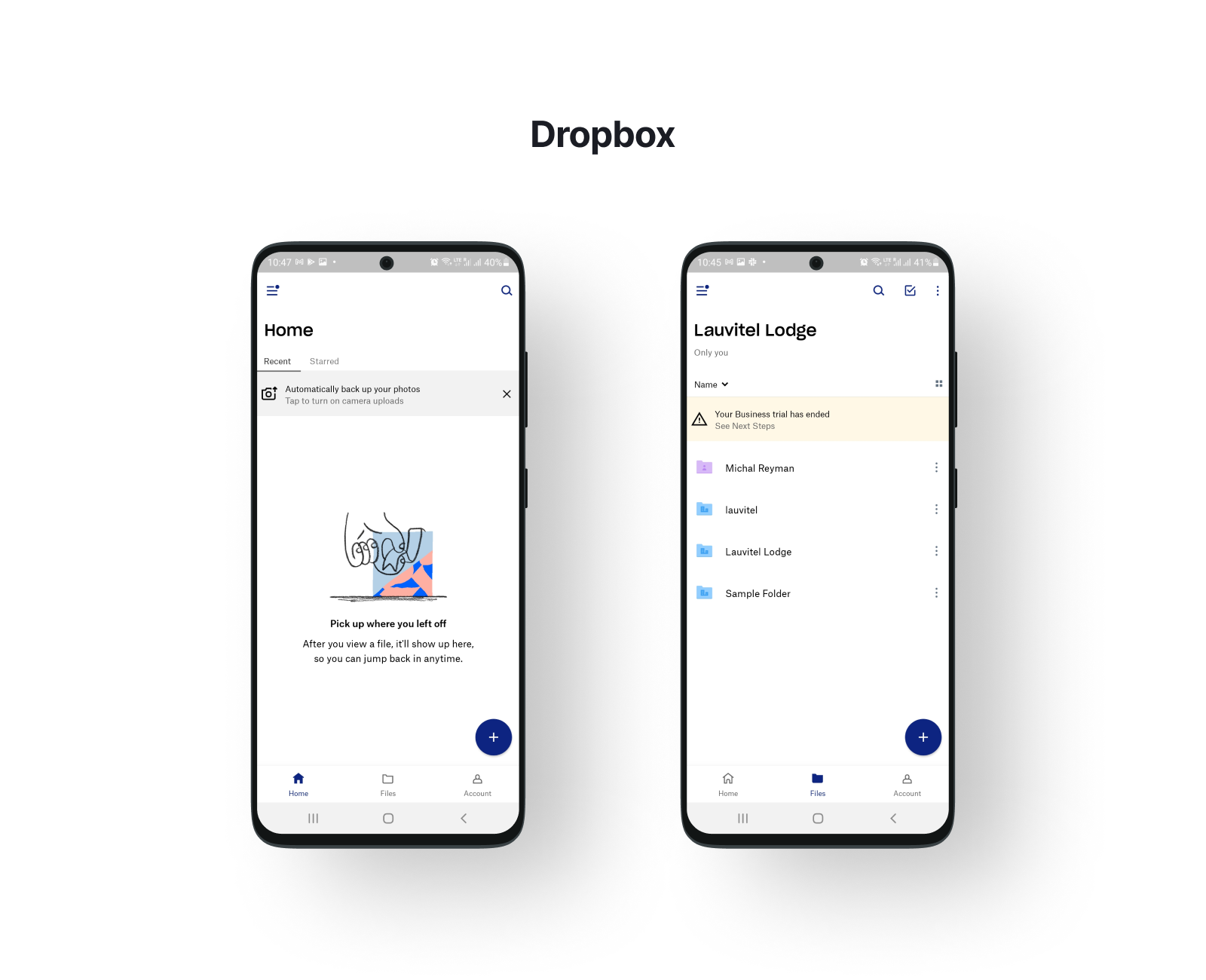
Dropbox is arguably the most popular cloud storage provider in the world. It is used by office workers, students, and school children with pleasure. Whatever your work is, it is convenient to store data of any type in the cloud and connect to it from several devices.
The Dropbox Android app allows you to edit documents in Microsoft Office formats. In addition, you can automatically save all your photos and videos from the camera. The folders you have created may be available to other users if you send them an invitation. It is also possible to work with individual files offline.
eBay

eBay is an Android application developed by eBay Mobile. This application is a lightweight client that simplifies the use of eBay services. The user has access to a huge catalog of products, which are divided into separate categories. Whether it's consumer electronics or stylish clothing, you will always find what you were looking for.
The app supports barcodes that are recognized by the device's camera. To fully use the program, you will need an eBay account. It allows you to shop, correspond with sellers, link credit cards, and more. The application is distributed completely free of charge and does not require spending money.
Podcast Addict
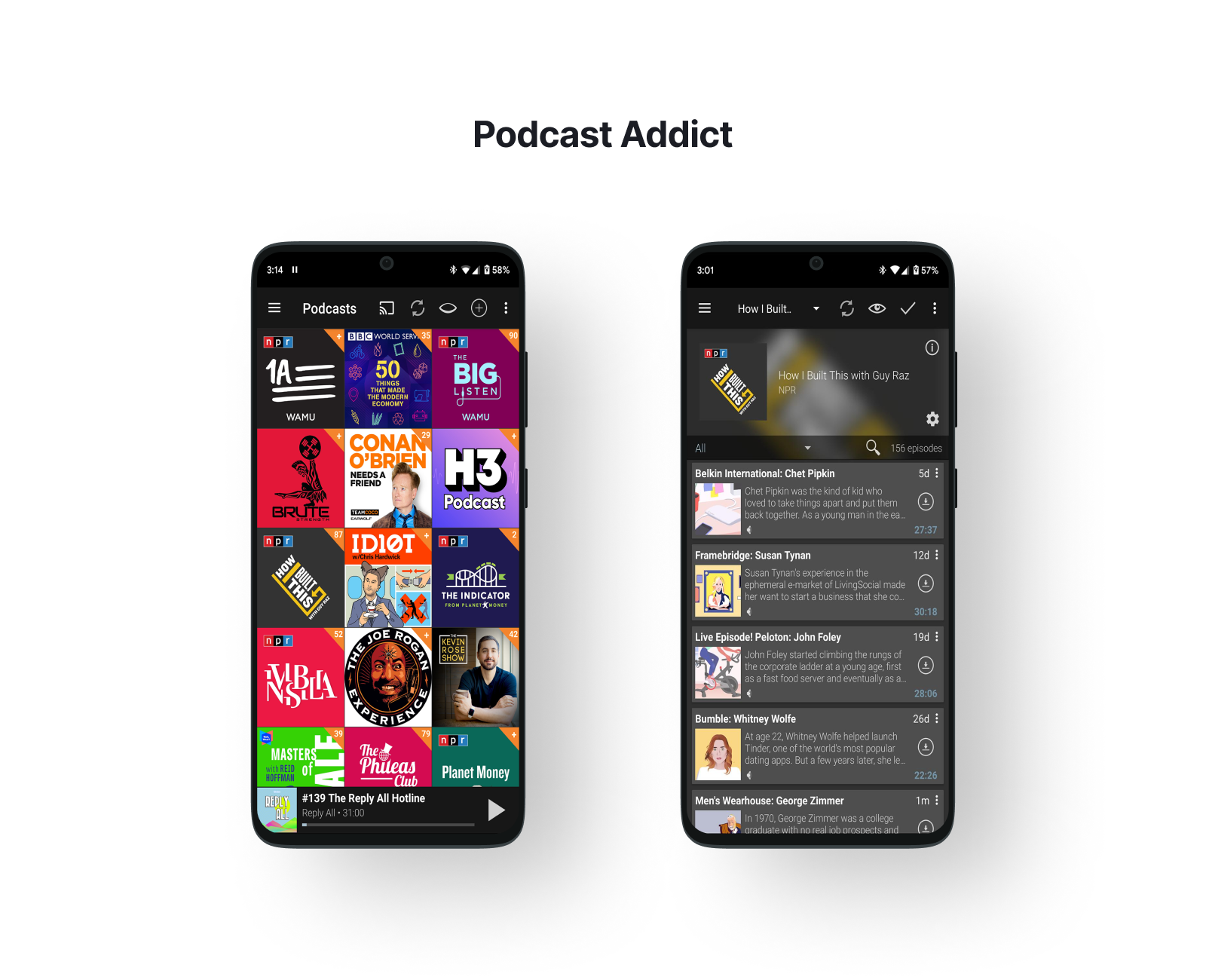
Podcast Addict is a great podcast app. Almost every podcast you can think of is featured here. Plus, it has a simple and efficient user interface, lots of organizational features, lots of play and download functions, and a paid premium version. You can browse podcasts by category or search for them individually. You can also set upload rules, create playlists easily, and it supports both Chromecast and SONOS as well as Android Auto and Wear OS.
The user interface and settings aren't the most elegant things we've ever seen. However, the app compensates for this by literally hitting every other field we could think of.
YouTube and YouTube Music

We really like the combination of YouTube Music and YouTube. For one price, you get unlimited music on YouTube Music with more than enough tracks to compete with Spotify and Apple Music.
However, you also get YouTube ad-free, as well as background video playback and offline downloads. This two-for-one bundle is right there with the $12.99 / month Hulu, Disney+, and ESPN+ package as one of the best deals for streaming video and audio.
In fact, both together should cover basically all of your video and audio streaming needs. Our only complaint is that the music quality on YouTube Music is below average.
Hangouts
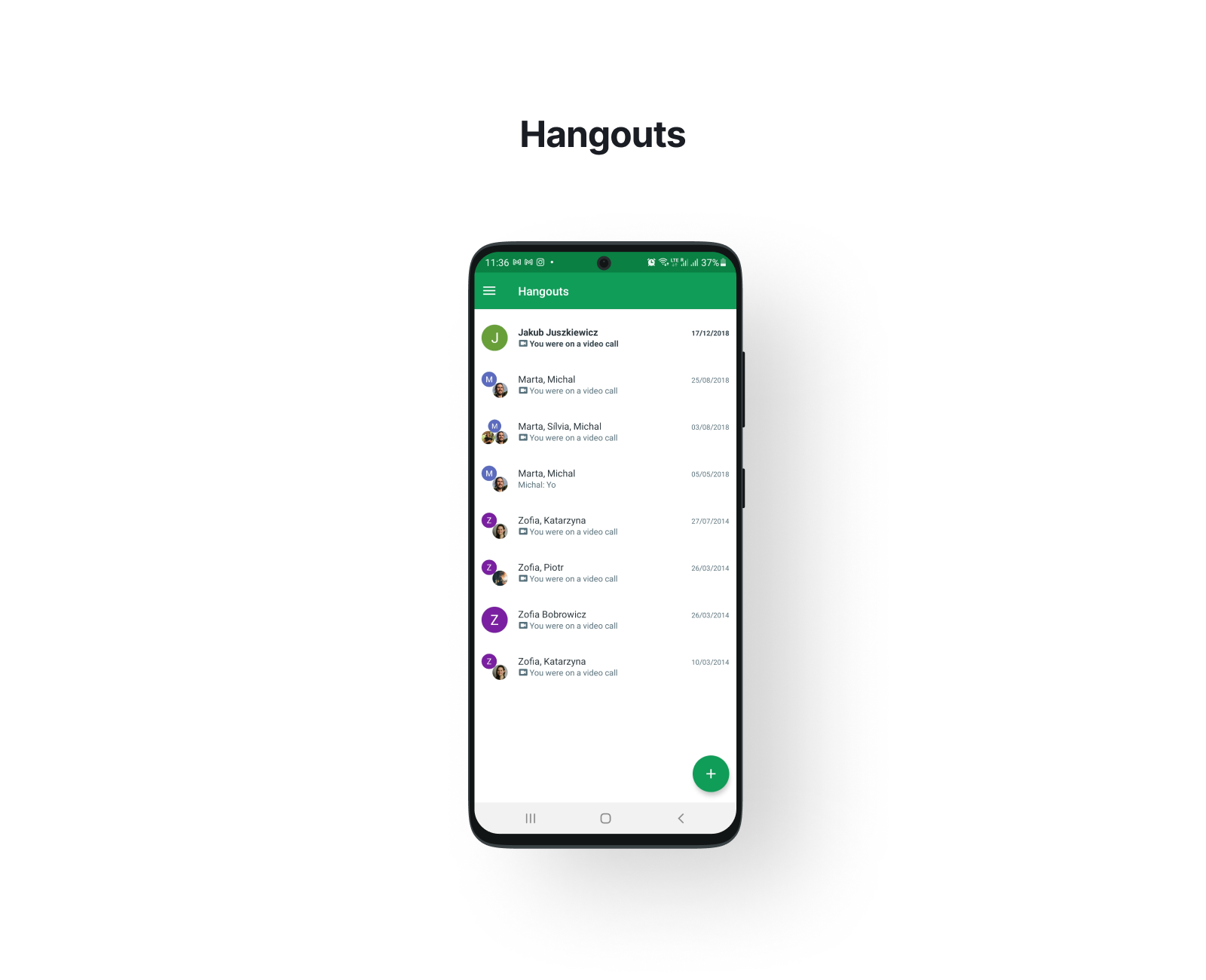
Hangouts is a multi-platform application developed by Google and is a kind of mixture of Google+ and Google Talk. The application has already managed to gain a large audience and prove that it can compete even with the most famous mobile messengers. Hangouts has become a kind of bug fix. The application developers have tried to preserve and enhance all the advantages of Google Talk while eliminating the numerous disadvantages of the service.
It should be noted that the developers are constantly improving not only the functionality of the application but also its interface. Hangouts boasts a lot of competitive advantages. The application is completely free, supports not only text chat but also video conferencing. In addition, the advantages of this messenger include a large selection of emoticons, as well as the ability to send photos and GIFs. Hangouts not only interacts with almost all Google services but also automatically syncs your conversations across all devices.
The Bottom Line
We can't say that Android directly influenced a company's business gain. However, the impact of creating an app with the OS that covers about 80% of the market is well worth it.
Generally, the core features of their success are as follows:
- Save time and money
In today's competitive market, you need to continually update your application with the functionality you need. This is where a simple Android setup comes in handy. Android makes it easier to add or change features as needed than iOS. An Android app dev company can easily prepare a business application to meet user needs.
A simple installation can save the company time and money. It also helps to reduce TTM (time to market) in order to stay resilient in the face of growing competition. - High Flexibility
Android can help businesses improve productivity with customizable apps.
Android apps can also be easily integrated into the business ecosystem. Android apps are also compatible with the latest technologies such as AR, VR, and IoT. This is possible thanks to the flexibility and scalability of the Android OS. In a sense, Android apps can provide companies with a higher return on investment (ROI). - Competitive advantage
More than two billion devices are running the Android OS worldwide. This clearly shows the importance of this platform. If a company introduces an Android app, it is likely that it will quickly become popular. This further enhances the brand's value, and, ultimately, the company can record an increase in sales and repeat customers.
Here are the obvious benefits of Android apps that give companies an edge over the competition:
- Simple and efficient BYOD implementation
- Reach out to a huge audience
- Business-friendly features and quick modification
10 Android community
The Android community is really huge. It has developed thanks to the system's popularity. In turn, the popularity of Android is mainly due to the fact that it is "free." Releasing the free version allowed Google to join forces with many of the leading hardware manufacturers to create a truly “smart” smartphone. Android is also open source.
As per Statista, the number of Android smartphone users in the United States is growing. Since 2014, the total number of users has skyrocketed from 87.7 million to 130.6 in 2021.
As for the developers themselves, there are over 5.9 million of them in the world! (EvansData)
However, let’s dive deeper into more detail and find out what this community can bring you.
Biggest Android conferences
Android Dev Summit
Link: https://developer.Android.com/dev-summit
The Android Dev Summit is the annual Android event. This is the place where Android devs from all over the world come together in one place to talk, discuss and share ideas about what they love and what Android is.
Google I/O
Link: https://events.google.com/io/
Google I / O is an annual developer-focused conference hosted by Google to discuss the development of Google's open source technologies and services. Held at the Moscone Center (San Francisco, CA) in May or June since 2008.
Google I / O uses a style similar to earlier Google conferences such as Google Developer Day (May 2007) and Geo Developer Day (May 2006).
There are over 100 sessions running during Google I / O.
Google's name "IO" can mean "Innovation in the Open" or input / output. In addition, "I" and "O" resemble the binary digits "1" and "0".
Droidcon
Link: https://www.droidcon.com/
Droidcon is the name of the franchise of commercial conferences in Europe dedicated to the development of software for the Android platform. Droidcon conferences are the largest Android developer conferences held outside the US.
Upcoming events
FOSDEM - Kotlin DevRoom
Place: Online-only event
Date: 6 - 7 February 2021
Link: https://fosdem.org/2021/schedule/track/kotlin/
Devoxx
Place: Paris, France
Date: June 30 - July 2, 2021
Link: https://www.devoxx.fr/
GDG DevFest
Place: Lviv, Ukraine
Date: 4 October 2021
Link: https://devfest.gdg.org.ua/
GOTO
Place: Copenhagen, Denmark
Date: 7-8 June 2021
Link: https://gotocph.com/
Devoxx
Place: London, UK
Date: 1 - 3 November, 2021
Link: https://www.devoxx.co.uk/
GOTO
Place: Amsterdam, Netherlands
Date: 15-18 June 2021
Link: https://gotoams.nl/
ADDC
Place: Barcelona, Spain
Date: 23-25 June 2021
Link: https://addconf.com/2020/
Droidcon
Place: Berlin, Germany
Date: 13-15 October 2021
Link: https://www.berlin.droidcon.com/
360|AnDev
Place: Online-only event
Date: 22-23 July 2021
Link: https://360andev.com/
Droidcon
Place: New York City, NY, USA
Date: 30-31 August 2021
Link: https://www.nyc.droidcon.com/
Droidcon
Place: London, UK
Date: 28-29 October 2021
Link: https://www.london.droidcon.com/
Droidcon
Place: San Francisco, CA, USA
Date: 13-15 December 2021
Android blogs to follow
Google Developers has articles from Google developers, designers, and engineers. You will find reviews of new libraries and tools like the APK analyzer, as well as many tips and tricks.
Hackernoon has several contributors and has articles on much more than Android, such as machine learning. Other topics, such as using Gradle, are relevant to Android developers and the wider community.
AndroidPub is another site that is a combined effort of a number of authors. They talk about a number of specific concepts like why you don’t put put view ! = null checks in your presenters, how to delete everything from your Kotlin code and how to use RxJava and DiffUtil together.
My life with Android is all about building the architecture of your application. Hannes Dorfmann introduced Mosby to help developers implement the MVP pattern into their applications. He also wrote about the repository pattern and the much less discussed model-view-intent (MVI) pattern.
It was written by Chiu-Ki Chan, a software engineer with over 6 years of experience with Google. It provides lots of Android development tips with code examples and images.
It’s description says it all: “Coding Android like there's no tomorrow.”
Mainly Android tutorial and articles.
Android Hipster is a regularly updated blog full of guides and interesting articles. They also create podcasts and are active on Twitter, so be sure to ask them any Android questions you may have!
Android development podcasts
Donn Felker and Koshik Gopal go to great lengths to produce consistently great episodes on a wide variety of Android-related topics. They usually meet with other Android developers to discuss tools, libraries, templates, etc. Everything is about the world of Android development.
This podcast comes straight from the mouths of Google employees as it is hosted by Chet Haase and Thor Norbay from the Android team at Google.People love this podcast because it usually offers a deep dive into Android themes, usually including guests who actually work with the tools / libraries. Because of this, we think it offers a level of understanding that is difficult to replicate elsewhere.
Talking in Kotlin with Hadi Hariri is a great resource if you want to learn more about Kotlin specifically. It covers everything from the Kotlin world, including Kotlin on Android, Kotlin Multiplatform, KotlinConf, etc.
The Context
The Context is another community-run Android development podcast hosted by the trio Artem Zinnatullin, Hannes Dorfmann, and Artur Dremov. This is another great option if you want to hear what other developers are working on and thinking about in the Android world.
droidkast.LIVE
Antonio Levia has a small set of interviews with other Android developers that conclude with a short tutorial.
It's fairly new, but it has many episodes and covers a wide variety of Android themes.
Android Leaks
A French Android development podcast. We don’t speak French, so we don’t really know much about it, but it’s out there.
Choose your Android app development course
The Complete Android N / Oreo Developer Course (Udemy)
Learn Android App Development with Android 7 Nougat by building real apps including Uber, Whatsapp, and Instagram!
Android Course & Classes Online – Learning Path (Pluralsight)
This course is specially designed to provide you with a complete experience, from nothing to professional Android development experience. No prior experience is required to enroll in these lessons.
Ionic 2/ Ionic 3 – Build iOS & Android Apps with Angular (Udemy)
One of the best Android development courses/ It takes you through the development path with Angular. To begin this training program, you will need a basic understanding of Angular, HTML, JS, and CSS.
Android Developer Nanodegree Certification by Google (Udacity)
This nanodegree is designed to help you reach your full potential in this area. In the lectures, you will take the first steps toward creating applications and publishing them on Google Play.
The Complete Android & Java Developer Course – Build 21 Apps
Fahd Sheraz and Paulo Dihone create magic when they come together. All of their online guides are highly rated and this is one of the best Android development guides.
Android development experts
Matt Dupree used to be a professor and now brings his academic perspectives to Android development. His posts are comprehensive but easy to read. He wrote about cryptography, quotes Nietzsche in his criticism of Divine Objects and why he doesn't use Robolectric.
Joeroen Mols is currently the lead Android developer for Philips Hue. He has written about unit testing, code coverage, continuous integration, and more. He has shared some of his projects, including a Wi-Fi File Transfer Tool on the Play Store, and has a useful and popular GitHub repository, LandscapeVideoCamera.
Mark Murphy has dived deeply into Android themes for a long time. He takes on serious topics and does it well. You can always count on him to explore the changes in the latest developer previews of the latest Android release, learn how to deal with particularly annoying issues like rendering PDFs, and network security concepts like pinning certificates.
Diego Torres Milano is an Android systems engineer, Linux advocate, and author of a book called Android Application Testing Guide. He is also the founder of CulebraTester and AndroidViewClient. On this blog, he has been sharing coding and testing stuff since 2006.
This is how he describes himself: “I am an engineer on the Android Developer Relations team. This is my personal blog, and any opinions expressed here are mine and mine alone.”
11 Android Today and Tomorrow
As an entrepreneur, you only want what's best for your business in the long run, right?
Well, one piece of advice we could give you is to choose the most popular mobile app development platform in the world — Android.
There are several business growth benefits of Android apps. In fact, we'd better start with statistics, which are the cornerstone of our argument for why Android business apps are a viable option both today and tomorrow.
As Android 12 prepares to offer its own set of business benefits, now is the time to choose Android as the main approach to mobile app development for startups.
Since numbers are best for calculating profitable business pursuits, check out this graph for the updated market share of OS platforms.
Android has more eagerly taken over the global market and has become the preferred choice of many hardware manufacturers, as well as users in general.
There are more pieces of evidence. Google Play, in the third quarter of 2019, had nearly 3x more initial app installs than the App Store, which totaled $ 21.6 billion during the quarter — an 11% increase year over year compared to the third quarter of 2018.
In fact, according to reports from Sensor Tower, Play Store revenues in Q3 2019 were $ 7.7 billion, up 24% from $ 6.2 billion in Q3 2018 — justifying the cost of developing apps for Android.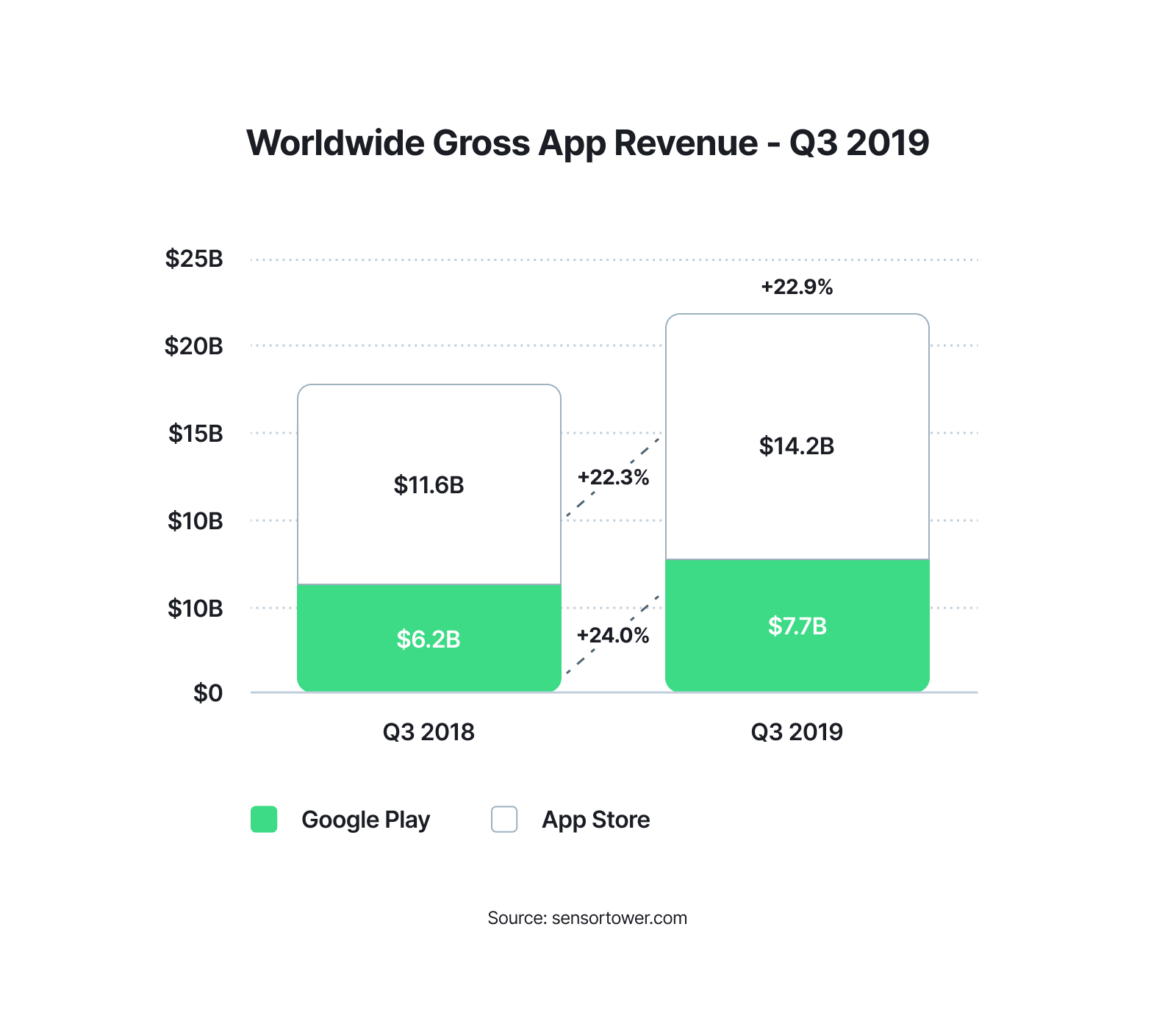
What's new in Android
Android 11
Regarding the newest version of Android, there are three main areas that need to be mentioned.
Behavioral changes
These are system changes that can affect how applications operate. Let's start with the permission changes. In Android 11, users can tweak location, microphone, and camera permissions more accurately. To be more precise, now the user can only grant access to the above listed objects once. Nowadays, it is possible to grant access to an application forever, which, of course, is not very good in terms of security. In addition, if the user has denied the permission request twice, the system will display a "Do not ask again" button to avoid having the user spammed with modals.
Developers also need to change how their app accesses the location in the background. Now applications cannot gain access using the modal window. To do this, a message should appear on the screen explaining the need for this permission, and after that, the user must independently grant the application rights.
Now it is difficult to get rights to system files. To do this, the application will also have to provide a link to the corresponding internal menu, in which the user must independently provide access to the files.
Security
Android 11 uses Scoped Storage as standard. It allows an application to request access only to specific files, rather than the entire file system. In addition, each application has a separate area of memory in the system that is isolated from other applications. This way, no application will be able to access another application’s files. One-time permission and background location access are also part of the security section.
API
Some monitors have built-in image enhancement tools, but the data transfer rate suffers — there is a noticeable delay. New displays with HDMI 2.1 support have an automatic low latency mode (ALLM) that minimizes latency by disabling post-processing. Android 11 can now understand if the TV supports this mode and will offer to activate it upon connection. This is especially useful for gaming and video conferencing where every millisecond counts.
In Android 11, the API for working with neural networks has also been improved, as well as the work with biometrics. A nice innovation in the update will be a new file system:
“Google is working on a new - incremental - file system for Android, which will debut in future Android updates. It is an advanced analogue of the Linux virtual file system. It will allow you not only to use applications during the installation of updates, but also to activate them during the initial download. That is, in order to launch the game, it will be enough just to click on the download button in Google Play, and the game world will begin to load gradually as you progress,” the official website states.
What is the future of mobile app development?
Andy Rubin, one of the creators of the Android OS, often makes predictions about Android’s future, and most of the predictions come true. In addition, he has worked on many promising areas in hardware and software development in the past. These directions almost always move from purely conceptual to real.
Earlier, Andy Rubin expressed a similar opinion about the current "kingdom of AI" in the mobile sphere. But now it seems that this opinion has finally taken shape. He believes that in the future, AI (its single form) will support the work of all mobile devices in the world. At least, those that are connected to the general network.
In his opinion, the combination of quantum computing and a weak form of AI can give rise to a strong form of AI that will rule everything. Now Rubin is engaged in both quantum computing (he is investing in one of the companies working on the implementation of this type of technology in conventional devices), and developments in the field of AI. Quantum computing, he said, should lead to an exponential increase in computing power.
Not long ago, Rubin founded Playground Global, which, at first glance, combines the features of a business incubator and a consulting firm. But, in reality, this company works differently. It not only invests money and advises, but also provides a fairly large staff of professional technologists who can help solve almost any technical problem. The company provides the author of the idea with the basic elements of hardware and software, and the author can focus not on the details, but on the concept. A kind of modular principle that can work in a business environment.
Rubin is convinced that there is no need to be afraid of the appearance of Skynet — everything that is being done in the field of AI now is for the best. True, many outstanding minds of our time do not agree with him — Hawking, Musk, Bostrom and others. Who is right and who is wrong? The future will judge. But the era of AI is clearly getting closer and closer.
What is the future of Android?
Google is currently actively working with Samsung to improve the Android operating system, which will make the platform convenient for owners of smartphones with foldable displays, which are the future of the industry. Manufacturers have already suggested several ideas for improving the operating system, but, as per Lockheimer, this is clearly not enough for it to be considered adapted for use on folding devices.
According to Lockheimer, “We have a lot to learn about how users interact with foldable smartphones thanks to [Galaxy Fold and Huawei Mate X],” says a senior executive. - “The same can be said about software developers who are no less interested in understanding the phenomenon of devices in a folding form factor. It is possible that this process will drag on for several years, as happened with [applications] sharpened for touch screens. "
12 Summary
There are several facts supporting the idea that any business can grow faster if it has a mobile application to support it.
Thus, every business needs a mobile app to grow. Can’t explain this to your business partner?
Well, in addition to building audiences and building brand awareness, a mobile app for startups can help them measure business growth while providing a competitive edge.
Here, Android application development would be the best choice.
While it is true that Android and iOS are in fierce competition with each other, deciding which one to go for can be tricky as they have their own business advantages. However, even if you choose the benefits of Android apps over iOS, you can always try cross-platform development targeting multiple platforms to expand your reach.
Ready to develop on Android? Proceed by picking the most suitable Android app developer.
It would help if you circle back to chapters 7 and 8. Remember that, although there are lots of Android developers out there, finding the perfect ones may be difficult.
That’s why you should stop your search only for highly experienced Android app development teams.
Looking for Android experts to build your app? Get in touch with us. We have multiple mobile software consultants, designers and mobile developers skilled in every technology to help you build your next mobile product.
Liked this Android guide? Share it by clicking the buttons below.
Thank you for reading!
Work with our Android Developers
Execute your vision with battle-tested Android developers and mobile business consultants perfectly matched to your business needs.
Rated 4.8 / 5.0 by clients from various industries and locations.
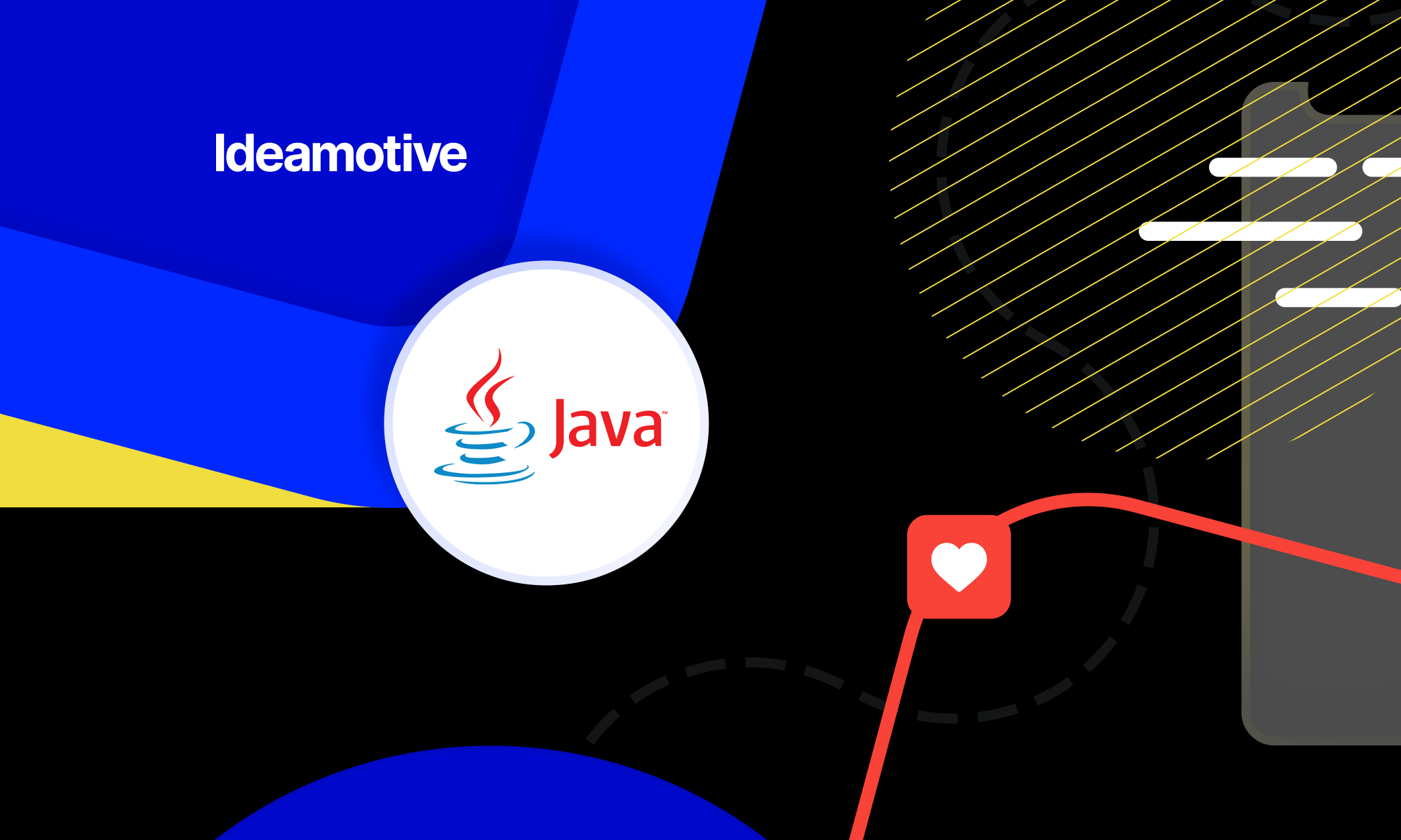

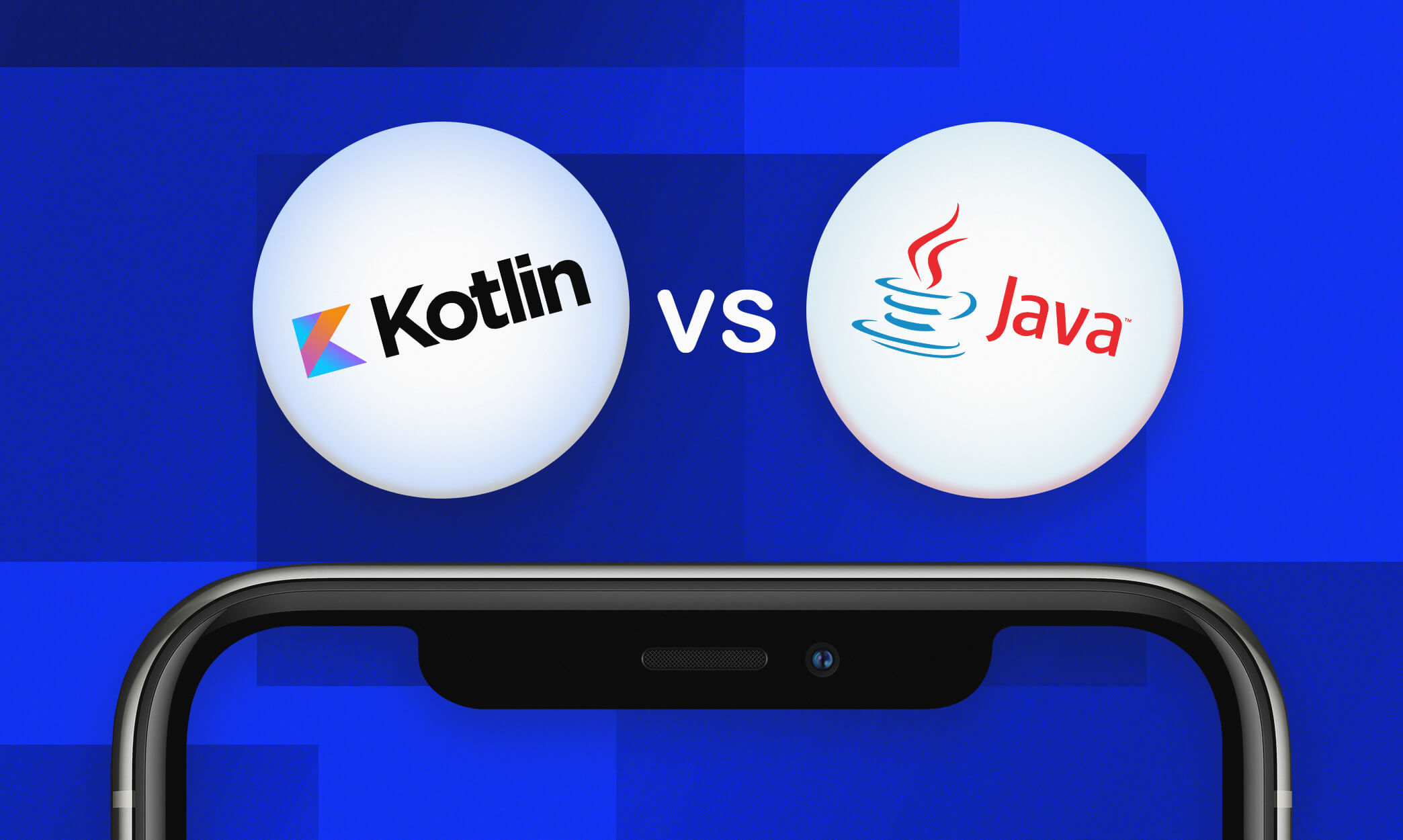

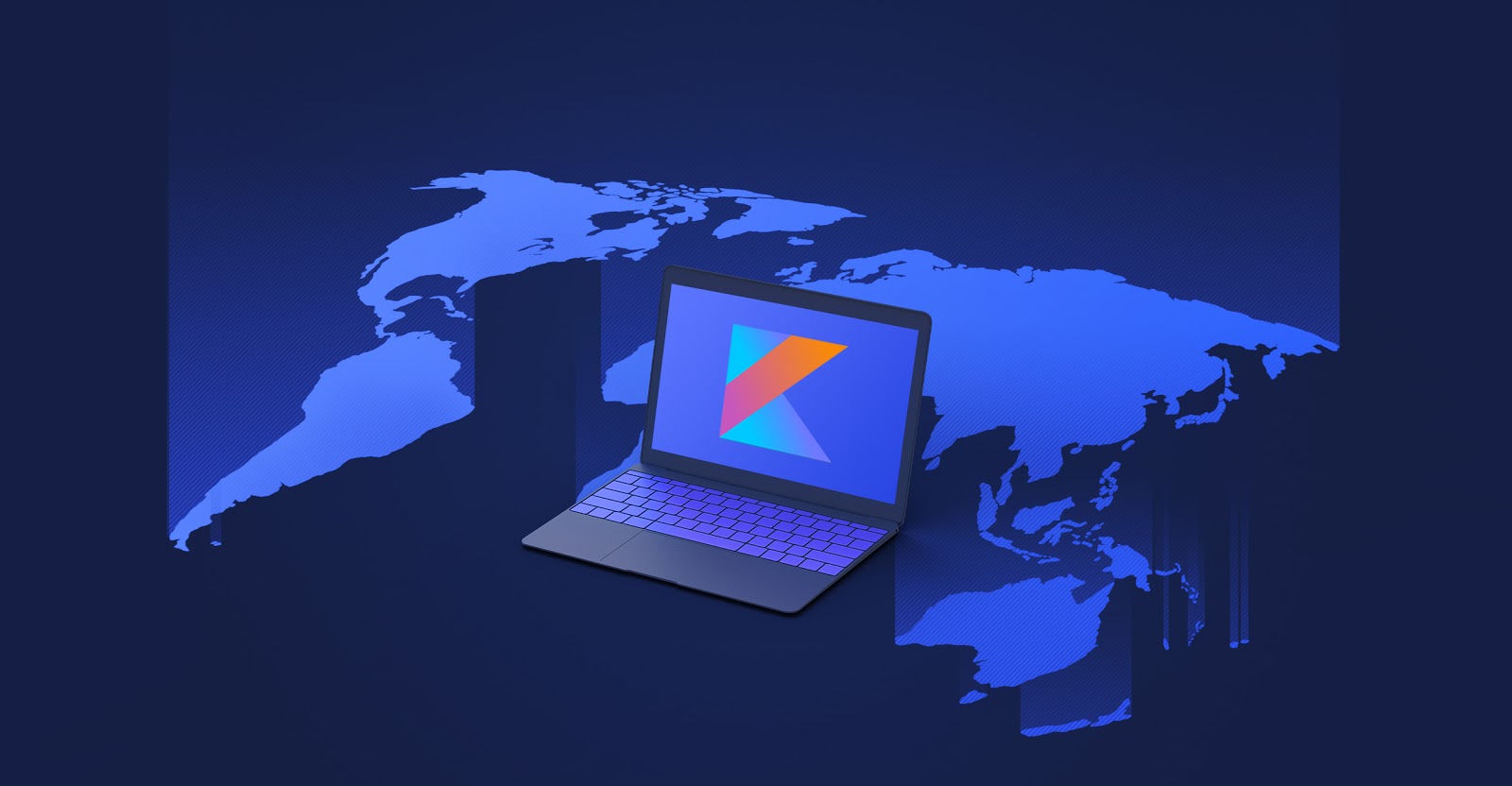

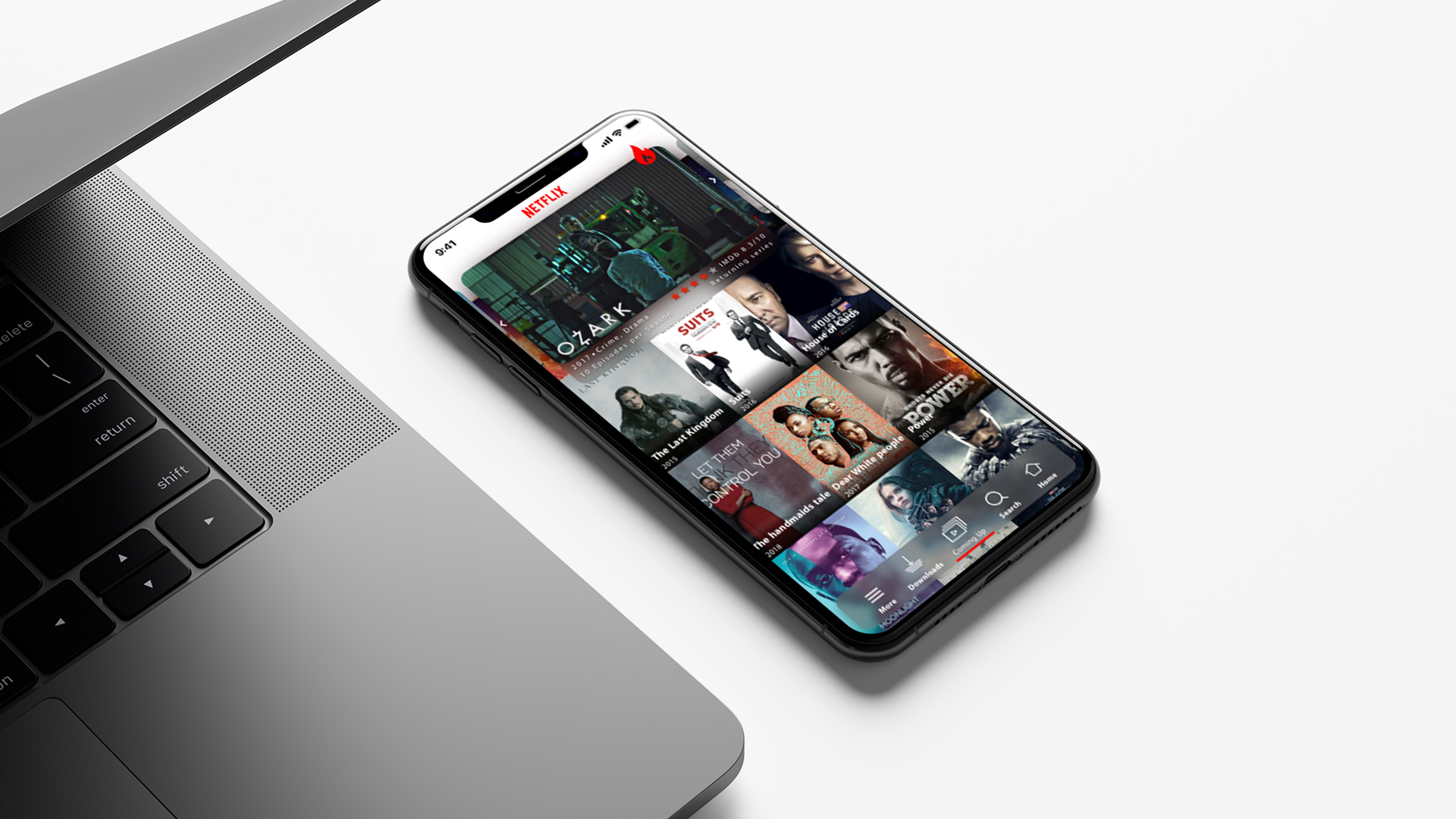
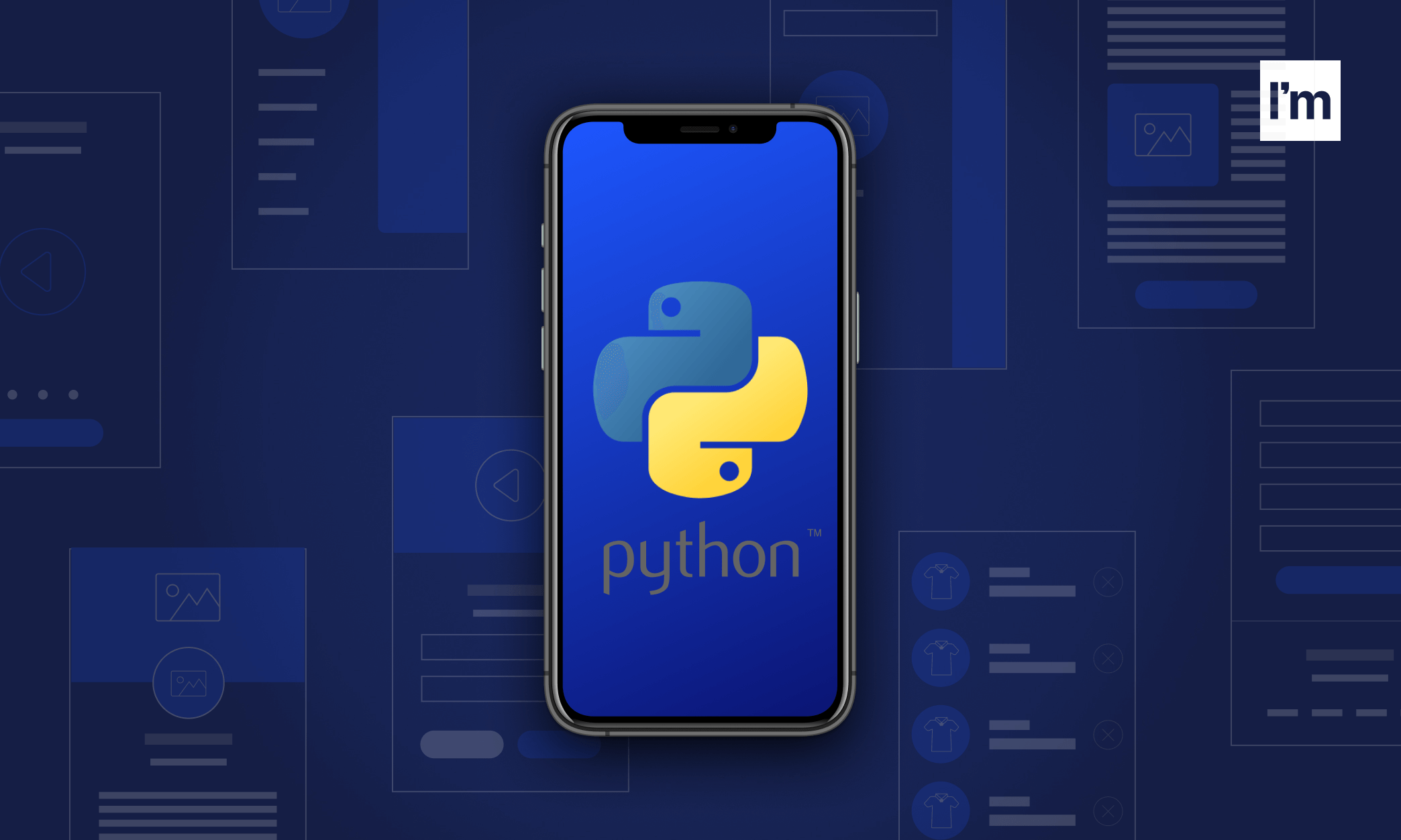
-png.png)
